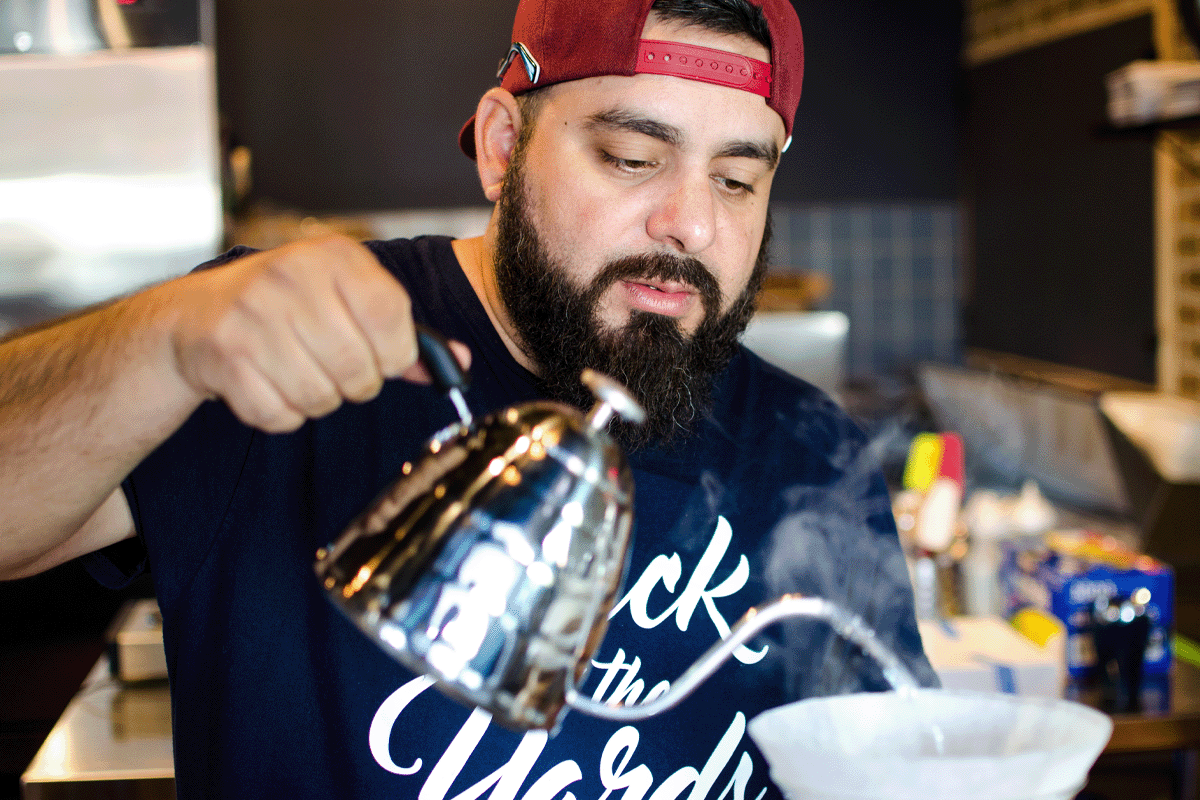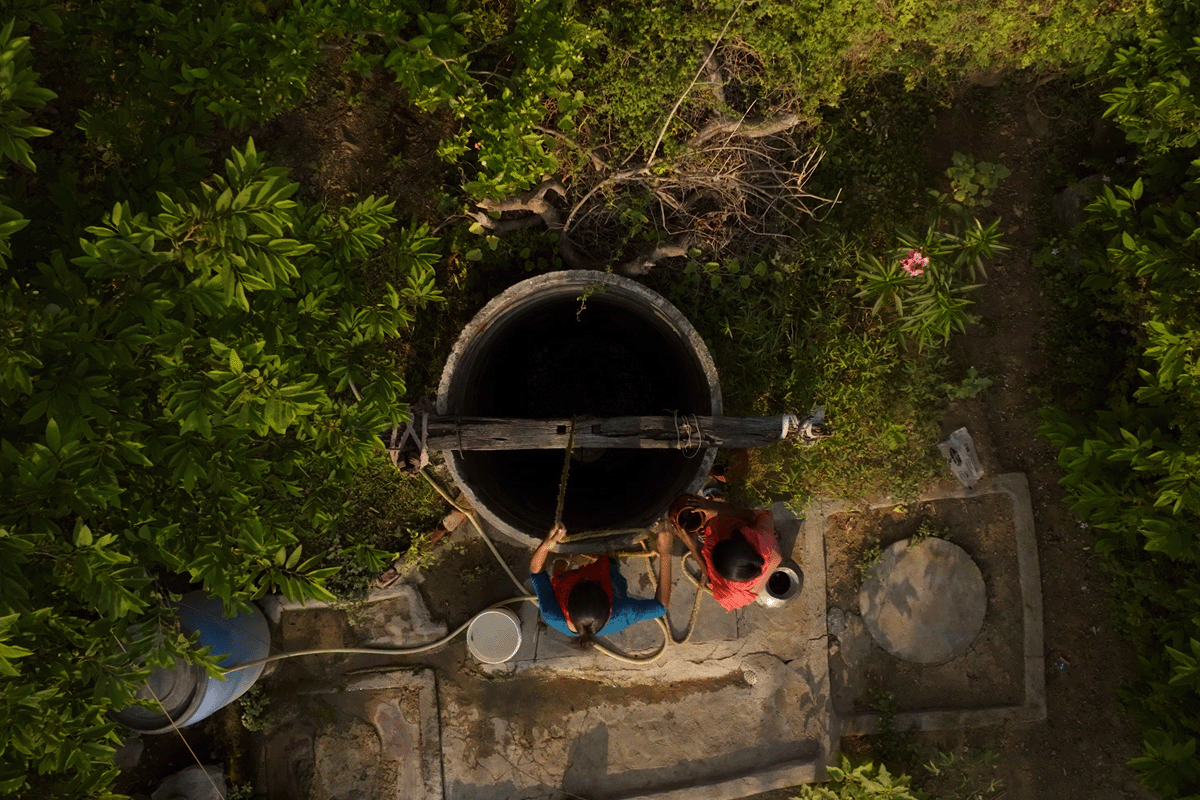Our business is only as strong and sustainable as our value chain.
Our value chain is extensive and complex, with operations spanning the globe to source ingredients, manufacture, package and deliver our foods and drinks to customers and consumers.
Guided by pep+, we’re integrating more sustainable and inclusive solutions across our value chain. From how we strive to reduce the impacts of climate change, to how we aim to address social inequities and improve access to nutritious food, these changes are not only good for our company but also encourage positive change for our business partners, people and communities that touch our value chain.
Specifically, we’re taking action aiming to help:
- Mitigate our climate-related impacts and adapt how we operate;
- Replenish high water-risk watersheds and reduce water use;
- Innovate more sustainable packaging and minimize waste; and
- Uplift our employees and communities.
In 2023, we continued to take steps to advance our pep+ ambitions across our Positive Value Chain pillar. We accelerated progress on some of our goals and maintained progress on others in our water and people agendas, while remaining focused on opportunities to expand and build upon our efforts in other areas such as climate and packaging. For more information on projects that advance key initiatives across our pep+ agenda, see the Green Bond ESG Topics page and our 2023 Green Bond Report.
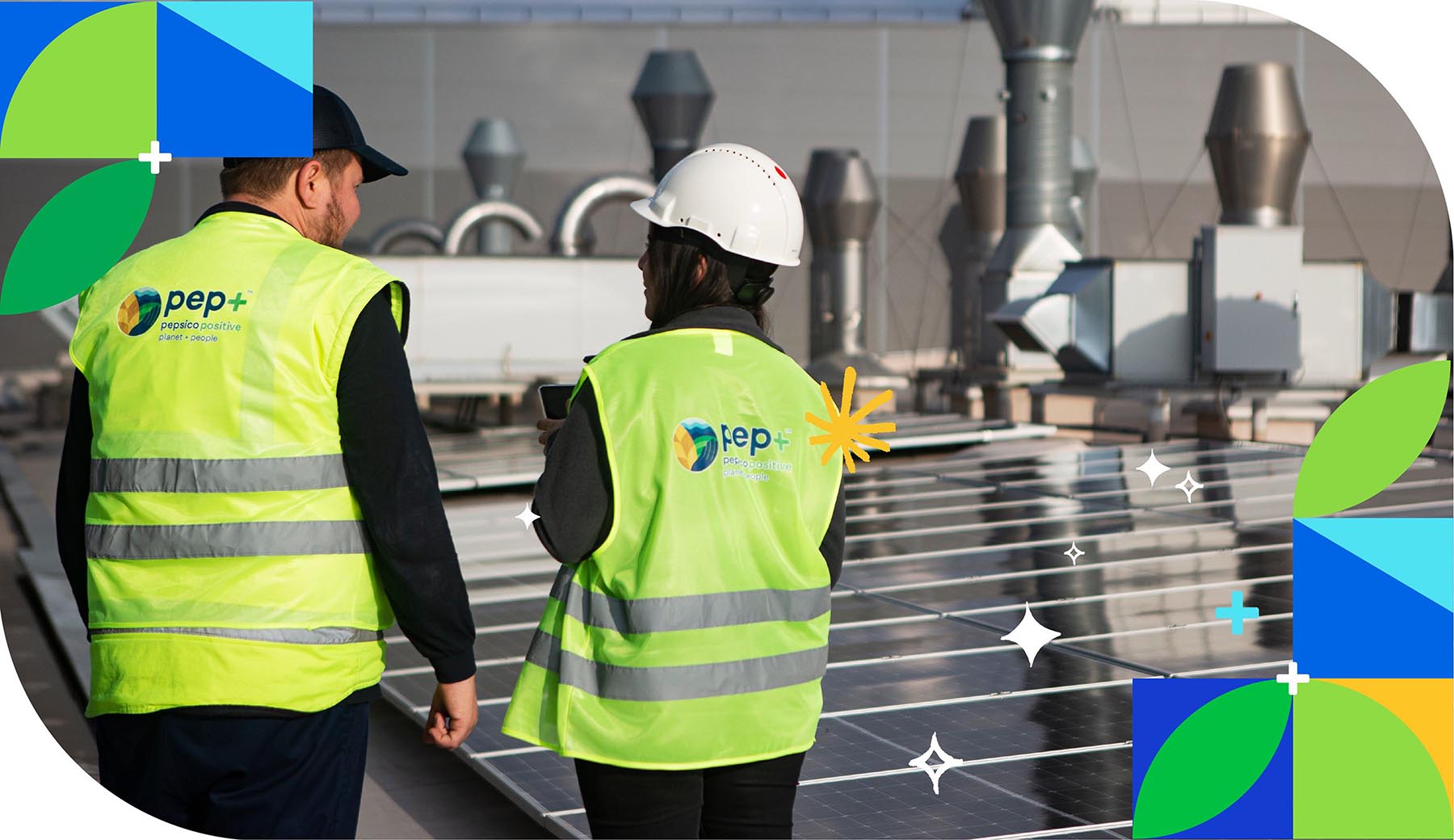
Climate
For our business, climate change has the potential to impact the quantity and quality of agricultural crops available for our products, create weather patterns that hinder the operation of our facilities and supply chain, and affect the availability and quality of the water we use. For our employees, farmers and the communities that touch our value chain, climate change has the potential to threaten their prosperity and can negatively impact their health and well-being through food insecurity and exposure to extreme weather.
For these reasons, we are focused on implementing solutions that mitigate and adapt to the effects of climate change.
In 2021, we established a goal of achieving net-zero GHG emissions across our value chain by 2040 — one decade earlier than called for in the Paris Agreement.
To help achieve this, the Climate Action Strategy we also established in 2021 included three more near-term interim science-based GHG emissions reduction targets:
- Reduce absolute emissions across our value chain (Scopes 1, 2 and 3) by more than 40% by 2030 (from a 2015 baseline).
- Reduce emissions from our direct operations (Scopes 1 and 2) by 75% by 2030 (from a 2015 baseline).
- Reduce indirect emissions from our value chain (Scope 3) by 40% by 2030 (from a 2015 baseline).
Despite the progress that we have made (see goals and progress discussion), our near-term emissions reductions goals face known and unknown challenges. We continue to review our goals in the context of new developments, including business growth, investments needed to meet the goals and steps necessary to maintain Science Based Target (SBT) alignment (which advises that targets are reviewed and, if necessary, recalculated and revalidated every five years at a minimum), as well as external developments.
Approach
PepsiCo’s Climate Action Strategy is centered around two pillars: mitigation and adaptation. We aim to take action in the areas within our control and aspire to influence action in our value chain that will have the greatest impact on our carbon footprint, which includes manufacturing, agriculture, packaging, transportation and vending and cooling equipment. We plan to continue to evolve what we do and how we do it — from how our ingredients are grown; to how we make, move, sell and package our products; to how we partner with others who share our ambition to extend our impact.
Our climate action strategy

Decarbonizing our value chain is a complex effort requiring a multi-pronged approach that leverages multiple options as we aim to achieve our goals. We know that our efforts do not occur in a vacuum — they rely on the developments of the wider systems in which we operate. Key areas, such as modernization of electrical grids and development of affordable renewable fuel supply, will influence our progress as we work towards decarbonization. We’ve learned a lot as we’ve tested different technologies to decarbonize and plan to continue to implement scalable solutions that are available today, while also investing in new promising technologies.
These solutions may hold the potential to be replicated at PepsiCo facilities around the world and serve as building blocks to scale decarbonization beyond our company walls.
In 2023, we:
- Set out guiding principles — Sustainable Operations from the Start — that require all new operations, including building new manufacturing and distribution sites as well as expanding lines within existing operations, to be funded, scoped and activated with net-zero emissions and net water positive outcomes in mind.
- Continued to acquire new electric, hybrid and natural gas vehicles to expand our sustainable fleets in the U.S., Latin America and Europe. For example, Frito-Lay North America (FLNA) unveiled its first-ever 100% fully-electric vehicle site in Charlotte, North Carolina; new electric vehicles deployed in Mexico will enable PepsiCo to reduce approximately 2,800 metric tons of CO2 annually when compared to the gas-powered equivalent; and by the end of 2023, 80% of PepsiCo Romania’s owned fleet transitioned to hybrid vehicles.
- Continued to expand our use of new sources of renewable energy like biogas, which takes manufacturing byproducts (such as dried corn husks and potato peelings) and converts them into biomethane, a renewable fuel that can be used to generate electricity. We also scaled the use of hydrotreated vegetable oil (HVO) — used cooking oil — across our supply chain in the U.K. Now, in partnership with transportation partner, AB Texel UK, 240,000 tons of potatoes each year are transported from British farmers to our Leicester site in trucks powered by HVO.
- Assessed the energy efficiency of coolers by completing a year-long joint assessment with one of our bottlers in Europe, Royal Unibrew, of past, current and future GHG outlooks. Findings are helping us prioritize more efficient technologies in the future which are expected to reduce cooler-related emissions by more than 30% between 2023-2030.
- Invested in developing more sustainable facilities, such as our $320 million production facility in Poland that opened in May 2023, which incorporates renewable energy for operations, implements measures to reduce water waste and aims to be net zero by 2035, and a £58 million investment in our Walkers facility in Leicester to progress our packaging and related nutrition goals. Our facility in Cork, Ireland became fossil fuel-free in 2023 and has transitioned away from natural gas by pioneering the use of HVO to power the facility’s operations.
We’re also incentivizing employee participation in our climate action journey by adding pep+ as a category to our internal awards program, Smiles, which empowers employees to recognize one another for actions taken that support pep+. We continue to expand our Green Teams, a grassroots network that helps employees become more sustainable at work, at home and in their communities. Currently, we have over 200 Green Teams globally.
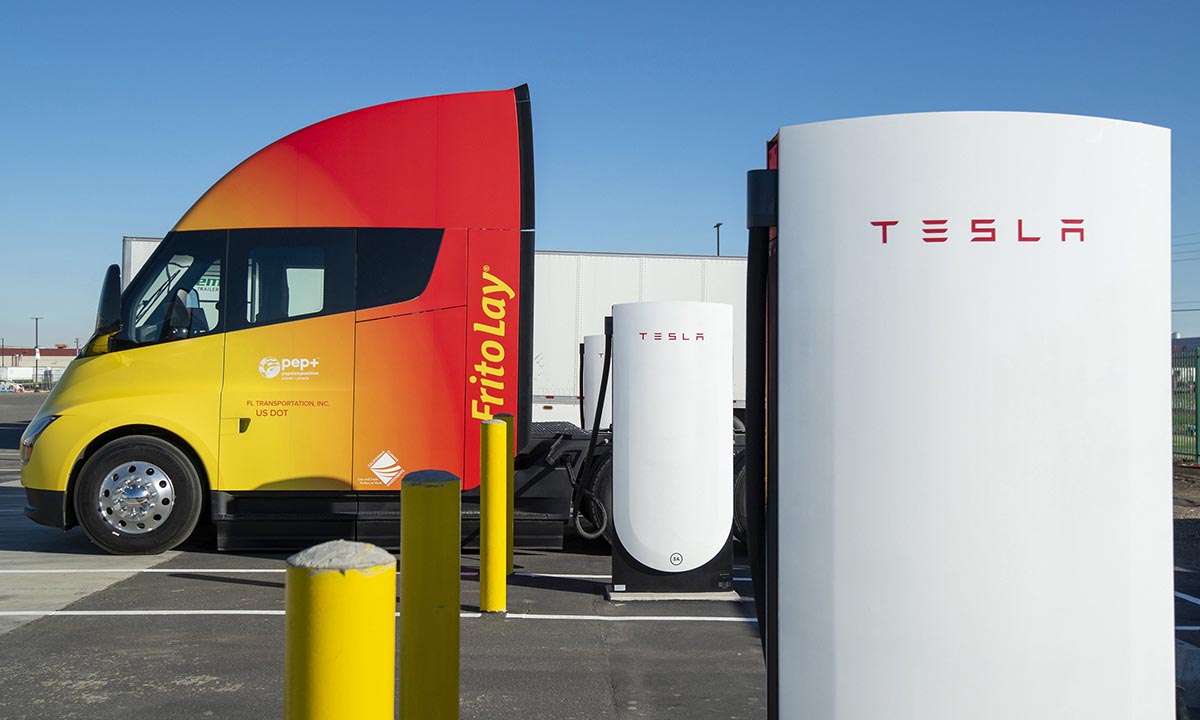
3MM+
zero emissions electric miles driven
by PBNA and FLNA collectively in 2023
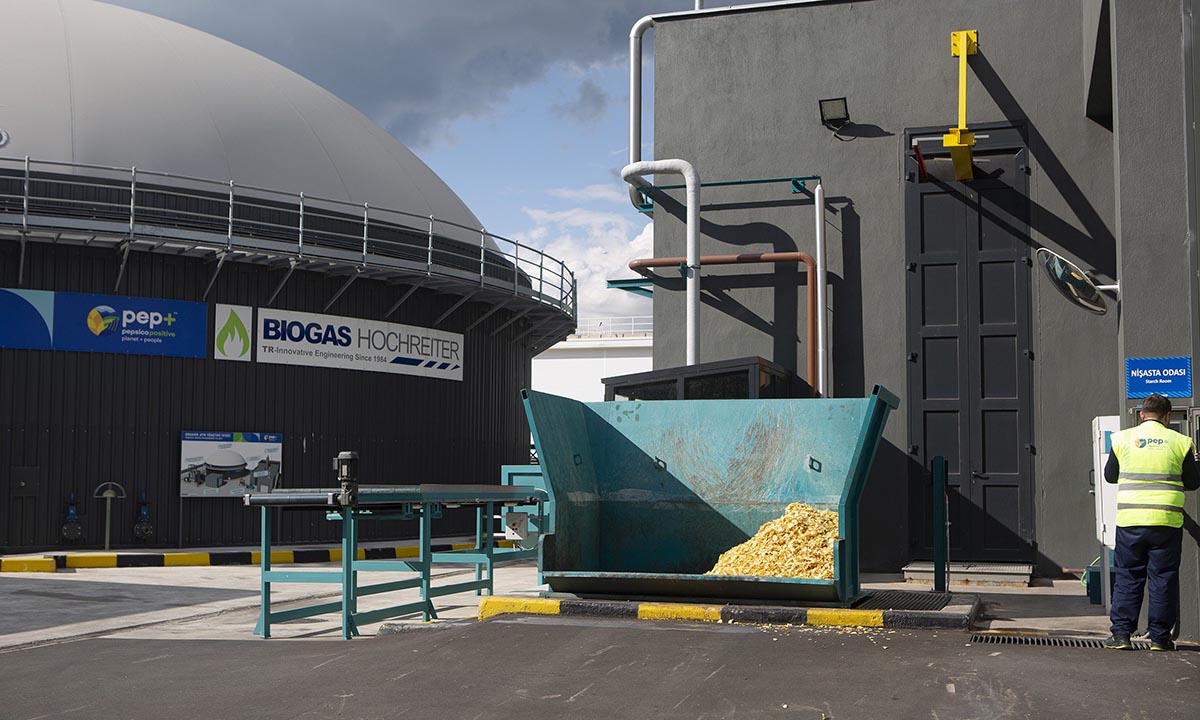
12
biogas installations
globally
Addressing climate change across the value chain
Consistent with previous years, the majority of our carbon footprint in 2023 (94%) came from our Scope 3 emissions, particularly the following three key categories: agriculture (37%), packaging (26%) and third-party transportation and distribution (11%).
Like many large, global organizations, reducing Scope 3 emissions is the biggest challenge we face in advancing progress toward our 2040 net-zero goal. Given the indirect nature of these emissions, quantifying and managing them is difficult and requires strategic partnerships and engagement to make progress.
We try to work with our value chain partners — including suppliers, contract manufacturers, franchise bottlers and customers — to help them improve the sustainability of their operations.
We believe there are three fundamental elements — expectations, economics and enablement — that are needed to have successful value chain-partner engagement and more importantly, value chain-partner action.
Expectations
Setting clear and consistent expectations with our supply chain partners helps lay the foundation for successful collective action. At our 2023 annual global Supplier Summit, we laid out four climate-related expectations and asked our top 200 suppliers1 to:
- Set or commit to set an SBT;
- Share an SBT-aligned decarbonization plan and annual progress;
- Report Scope 1 and 2 emissions; and
- For agricultural suppliers, collaborate with PepsiCo to develop an action plan for sustainable ingredients and to build regenerative agriculture acres.
Economics
With the scale and reach of our value chain, we may have an opportunity to remove barriers to pursuing decarbonization for our suppliers.
Examples include:
- Incentivizing tier 1 suppliers2 through our joint supplier financing program with Citi. The program offers key PepsiCo suppliers a lower rate on supplier financing if they reach certain ESG targets, such as optimizing the management of environmental resources and meeting thresholds on sustainable sourcing. After launching in Brazil in 2022, we’re looking to expand the program.
- Accelerating the adoption of renewable electricity in our value chain through pep+ REnew by helping value chain partners to access renewable electricity choices.
- Equipping our tier 1 suppliers in Asia Pacific, Australia and New Zealand and China Region (APAC), with the skills and knowledge required to access clean energy through the Clean Energy Procurement Academy, an initiative launched alongside other global companies and the Clean Energy Buyers Association that is designed to accelerate the integration of clean energy into global supply chains and aims to spur renewable energy policy change where renewable power has historically been more challenging to source.
Enablement
PepsiCo has a long history of working together with stakeholders to advance shared sustainability goals.
Building on the success of our pep+ Partners for Tomorrow platform for customers in North America, we introduced the global platform pep+ Partners for Tomorrow – Sustainability Action Center to a broader range of value chain partners, including suppliers, contract manufacturers and bottlers. The platform is available in multiple languages and provides access to a suite of resources and capability building programs.
We also aspire to work closely with our farmers and other supply chain partners to scale regenerative agriculture practices as we aim to reduce carbon emissions.
1. By GHG impact
2. Tier 1 suppliers are the direct suppliers of PepsiCo
Progress against 2021 goals
In 2023, PepsiCo’s total GHG emissions across Scopes 1, 2 and 3 were approximately 58 million metric tons, which represents a 4% decrease from the 2015 baseline and a 5% reduction from 2022. In 2023, approximately 80% (nearly 3,500 GWh) of the company’s direct global electricity needs were met with renewable electricity mechanisms, including on-site solar, off-site power purchase agreements and renewable energy credits.
As described above, despite progress, our emissions reduction goals face systemic challenges that will require collective industry and government advances to overcome. We continue to review our climate goals and progress in light of such challenges. We remain squarely focused on identifying and scaling the solutions that will help us (and our partners) to deliver progress that align us with our climate ambitions.
Progress against 2021 GHG emissions reduction goal
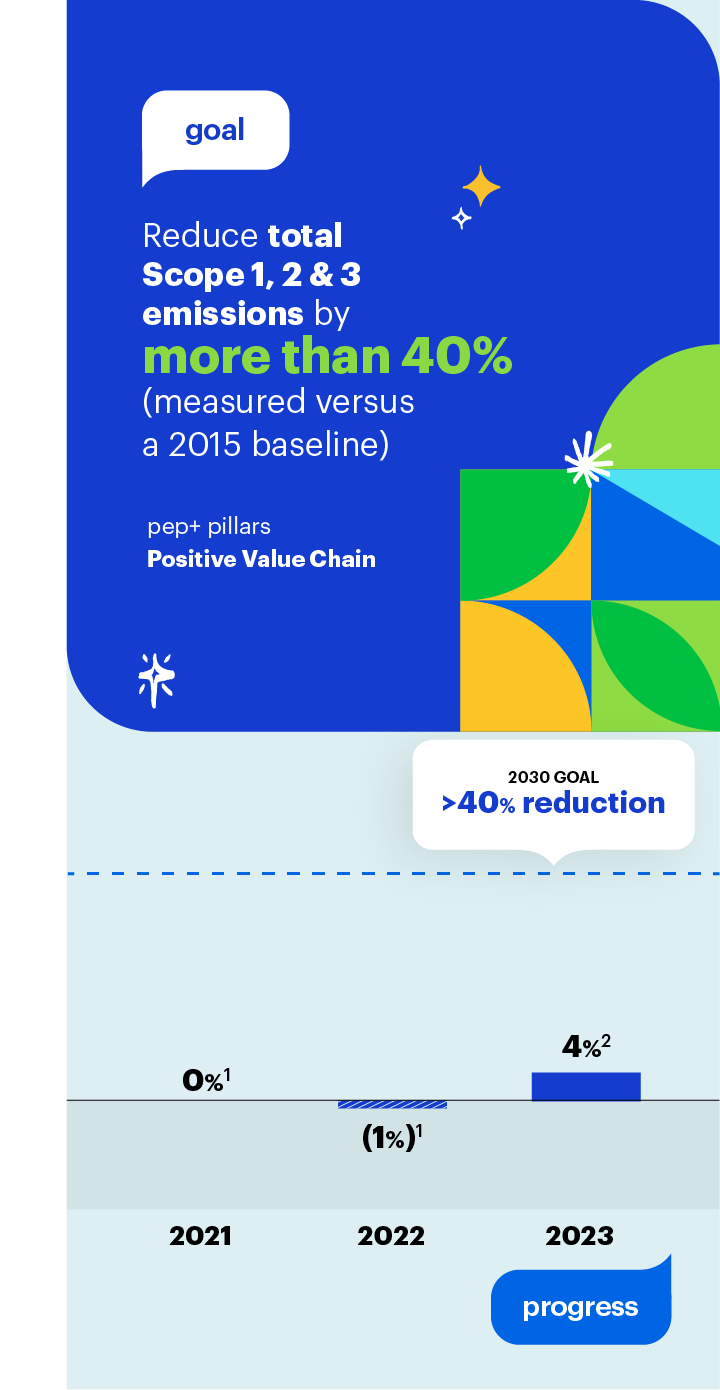
Progress against 2021 Scope 1 and 2 emissions reduction goal
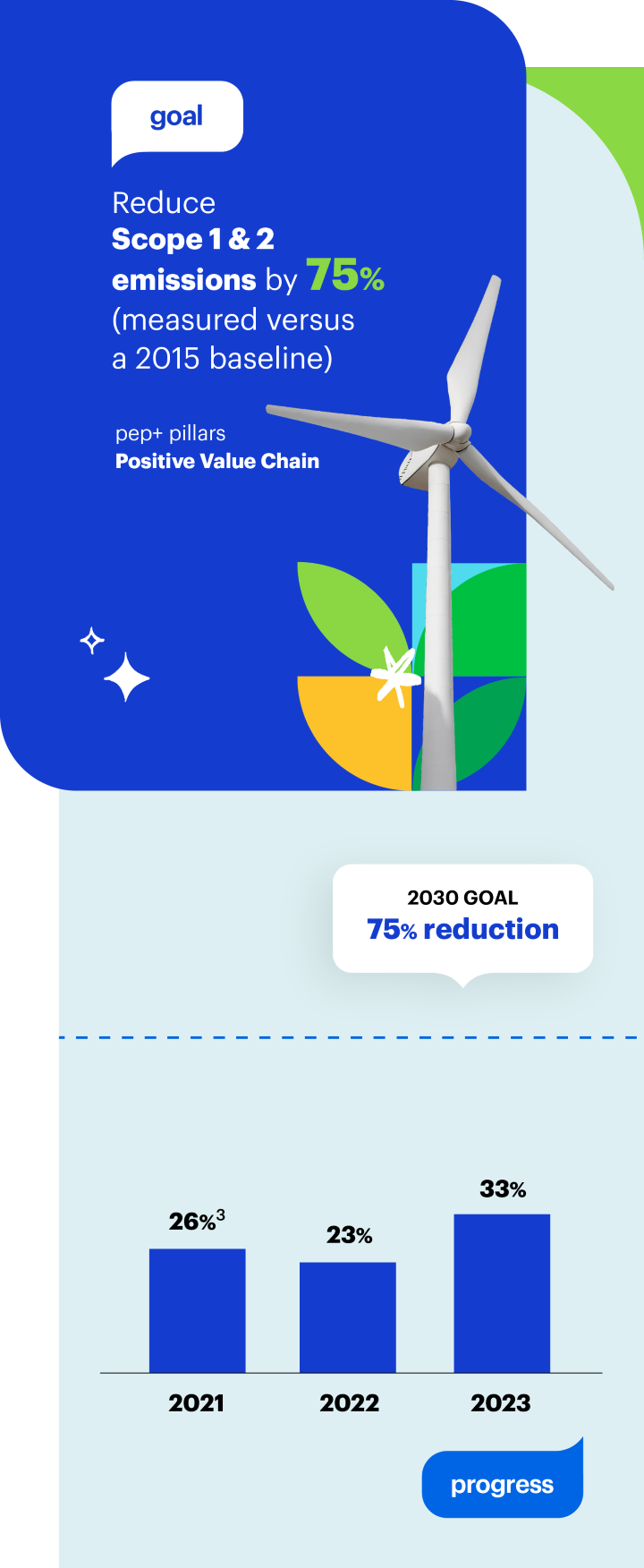
Progress against 2021 Scope 3 emissions reduction goal
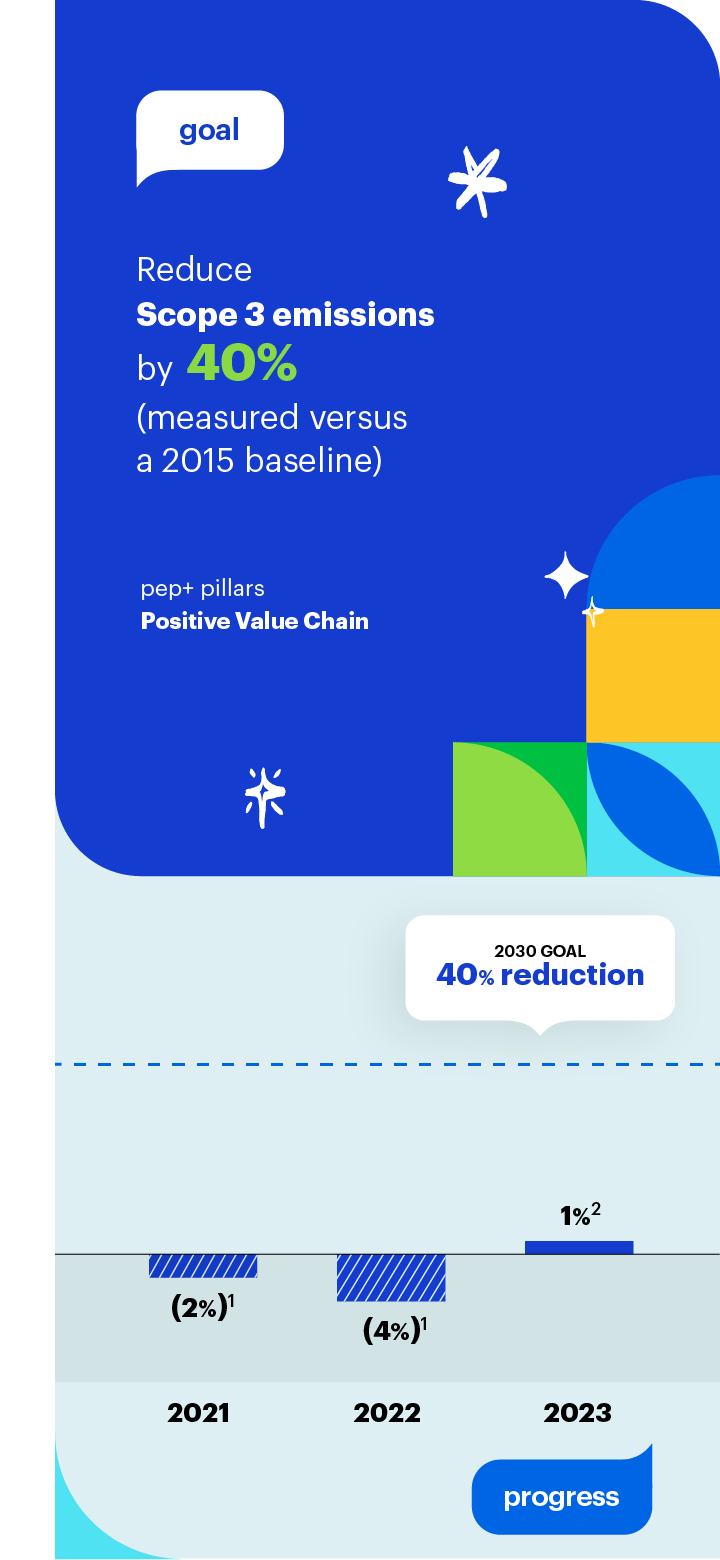
1. In 2023, we further remeasured the 2015 baseline to reflect the divestiture of Tropicana, enhancements in our calculation methodology and the inclusion of additional data. Where actual data was not available, estimated data was used
2. In 2023, we continued to enhance our calculation methodology and reflected the inclusion of additional data. Where actual data was not available, estimated data was used
3. In 2023, we remeasured the 2021 reported results to reflect the 2015 baseline that was recalculated following the divestiture of Tropicana
Explore Climate topics in more depth
PepsiCo's ESG Topics A-Z provides detail on strategy, data, policy, progress and more on a wide range of subjects.
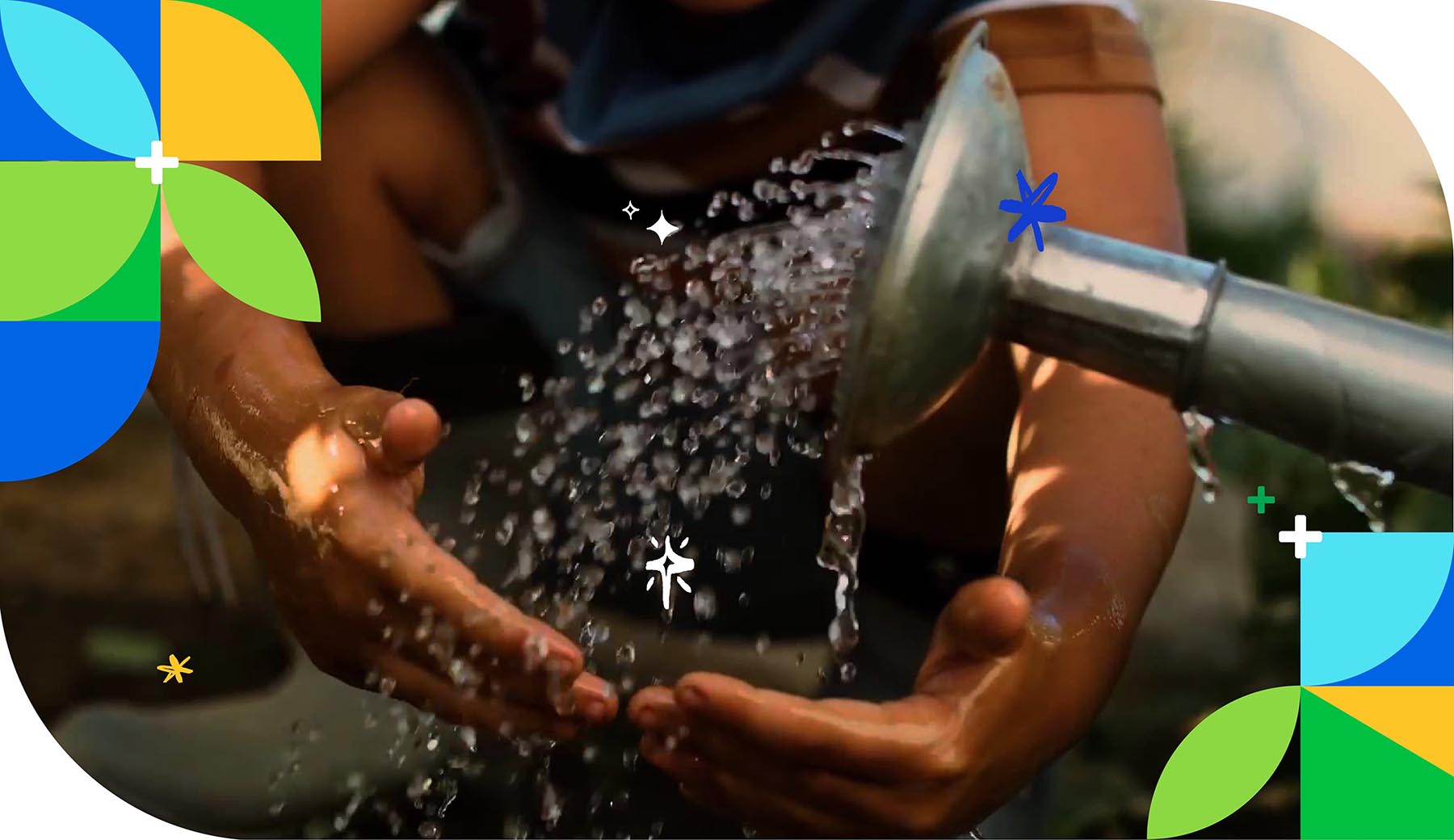
Water
Water is a human right, indispensable to every community, ecosystem and economy. It’s also a critical resource to PepsiCo’s business: it irrigates the crops we use, is a key ingredient in many of our products and is essential to ensuring we meet the highest product safety and quality standards.
However, water insecurity is a significant global challenge. With climate change and other factors placing a heightened burden on the global water supply, companies like ours can contribute their expertise and resources to help address these issues.That’s why we’re working to become net water positive by 2030. This means we’re aiming to replenish more water than we use. Our vision is that wherever in the world we operate, water resources will be in a better state because of our presence.
We’ve set high standards for ourselves and our supply chain in support of this vision, including enhancing watershed management within our operations and across our agricultural practices, and contributing to broader community water health.
Approach
As one of the first companies of our size to acknowledge access to water as a human right, we take our goal of becoming net water positive seriously.
We’ve adopted an approach to watershed management that includes:
- Improving water-use efficiency across our value chain — including on farms and in manufacturing facilities;
- Replenishing water and improving the health of high water-risk watersheds where we operate; and
- Increasing safe water access for communities that face water insecurity, including scarcity and unsafe water sources.
Our path to net water positive

Within our operations, we’re focused on water-use efficiency
To make our operations among the most water-efficient in the world, we’re focused on scaling proven manufacturing processes and treatment technologies across our businesses and geographies, and fostering a culture of sustainability among our employees.
In 2023, we reached our 2025 target to achieve 25% improvement (against a 2015 baseline) in operational water-use efficiency in high water-risk areas1 — two years earlier than expected. To reach this milestone, we innovated and scaled solutions globally, including:
- Scaling a new approach to how we wash corn when making products such as Tostitos, Fritos and Doritos to more than 100 global manufacturing lines within a year. This corn hopper halo washer efficiency solution reduces the time the water is turned on by more than 85% during a phase of the corn-washing process.
- Implementing membrane bioreactor technology at 21 manufacturing sites globally, including 14 in high water-risk areas, to treat, purify and recycle processed water to drinking-level standards for reuse in operations. This can allow a site to reduce its freshwater demand by an average of 70% compared with prior technology.
- Evaluating water treatment technologies around the globe that improve the efficiency of the production of ingredient water. For example, across PepsiCo Beverages North America (PBNA), we have led the development with Research & Development (R&D) on piloting technologies like Closed Circuit Reverse Osmosis (RO), High-Efficiency Recovery RO and Capacitive Deionization that reduce wastewater from the water treatment process used in the manufacturing of our products.
We also continue to expand our Resource Conservation (ReCon) program across PepsiCo facilities. This program identifies and shares best practices in efficient water-use. We are now offering ReCon training and site deep dives to bottlers and co-manufacturers, sending PepsiCo experts to these third-party locations to help educate and scale best practices.
As a longstanding member of the Alliance for Water Stewardship (AWS), we set one of our pep+ water goals to achieve 100% adoption of the AWS Standard in high water-risk manufacturing areas by 2025. Since 2022, we have more than tripled the number of facilities that have fully adopted the AWS Standard (from eight in 2022 to 27 in 2023), largely due to our Africa, Middle East and South Asia (AMESA) sector-based sites.
We strive to replenish more than 100% of the water we use in high water-risk sites
We must understand the conditions, challenges and risks of local watersheds to help improve the availability and quality of water in the communities in which we operate. To do so, we support collaborative solutions that address the specific needs of local watersheds and partner closely with farmers, landowners, state and federal agencies and NGOs.
Throughout 2023, we catalyzed targeted engagements to drive progress toward our net water positive goal.
- PBNA and FLNA announced a pledge of $3.3 million toward water replenishment projects across North America. PepsiCo's industry-leading efforts were recognized with the 2023 Industrial Water Reuse Champions Award.
- Our Alvalle gazpacho plant in Spain launched the second phase of a project to replenish the Segura River in early 2023, which returned approximately 70 million liters of water to the river — the equivalent of the annual consumption of the gazpacho plant — by replacing invasive cane with riparian woodland. This also improved local biodiversity.
- Through our strategic relationship with The Nature Conservancy (TNC), we are working to reduce consumptive crop water use during critical summer months along the Verde River, one of Arizona’s most important waterways. By partnering with local farmers to transition from high water use crops (such as alfalfa and corn) to barley, a crop that requires less water, nearly 240 million liters of water were replenished during the 2023 growing season.
- Through our strategic relationship with the World Wildlife Fund (WWF) in South Africa, we support watershed conservation efforts, including projects to remove alien vegetation, that have resulted in the replenishment of over one billion liters of water, created economic opportunities and preserved biodiversity in the Drakensburg region.
Applying learnings from our operational replenishment program, PepsiCo India and Mexico piloted watershed health programs that assessed the state of the water resources in the areas where our direct growers work and live. Recognizing that the communities and farmers outside of our supply chain use these same water sources, we are implementing holistic, system-wide programs designed to have a positive impact on the watershed for all water users in each of these areas.
We’re using our scale and influence to drive positive change beyond our walls
Water stewardship has long been a priority at PepsiCo, and we’re sharing our learnings with our third-party manufacturers and others. In 2023, PepsiCo was an active participant at the UN’s first Water Conference in nearly 50 years, engaging with NGOs, governments and peer companies on critical issues. We also launched an open-access online learning program on water with the platform Coursera. Courses include The Water Cycle, Water Security and Stewardship and Water Governance and Economics and each can be taken by anyone interested.
PepsiCo and the PepsiCo Foundation have also helped more than 91 million people since 2006 gain access to safe water through distribution, purification and conservation programs.Learn more about our efforts to improve agricultural irrigation efficiency and the strides we’re making toward our goal to deliver safe drinking water to 100 million people by 2030.
Learn more about our strategic water partnerships and engagement.
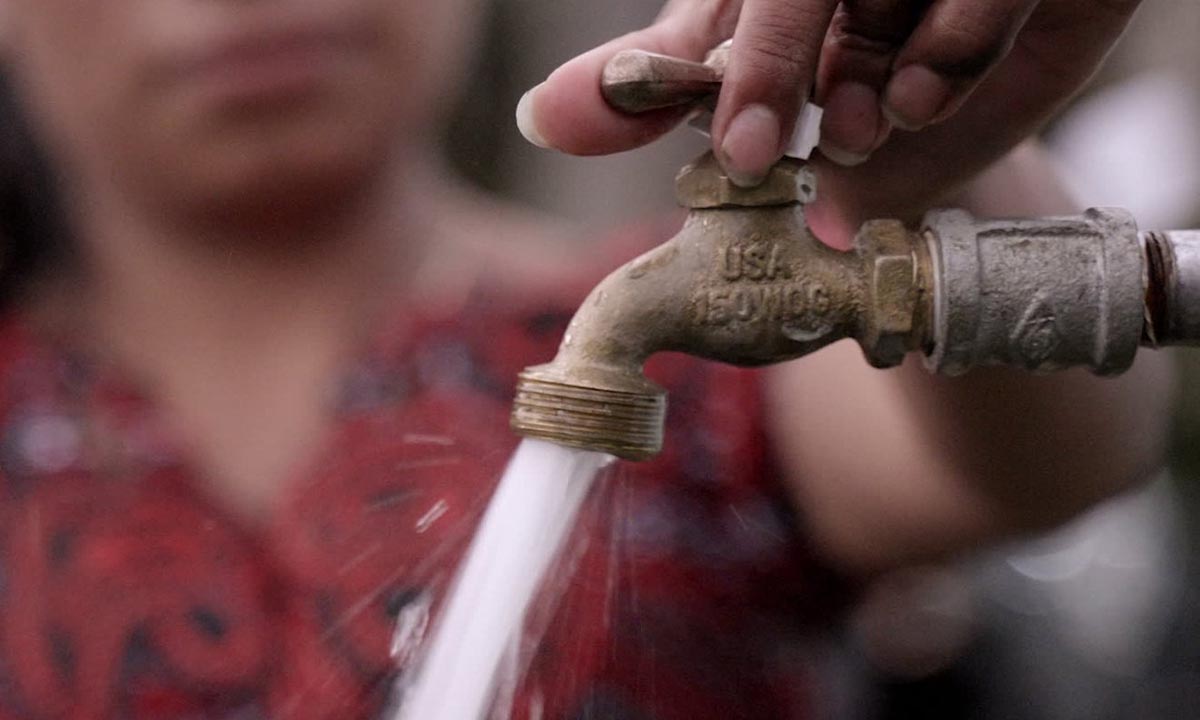
‘A’ List
score achieved by PepsiCo
for CDP Water Security
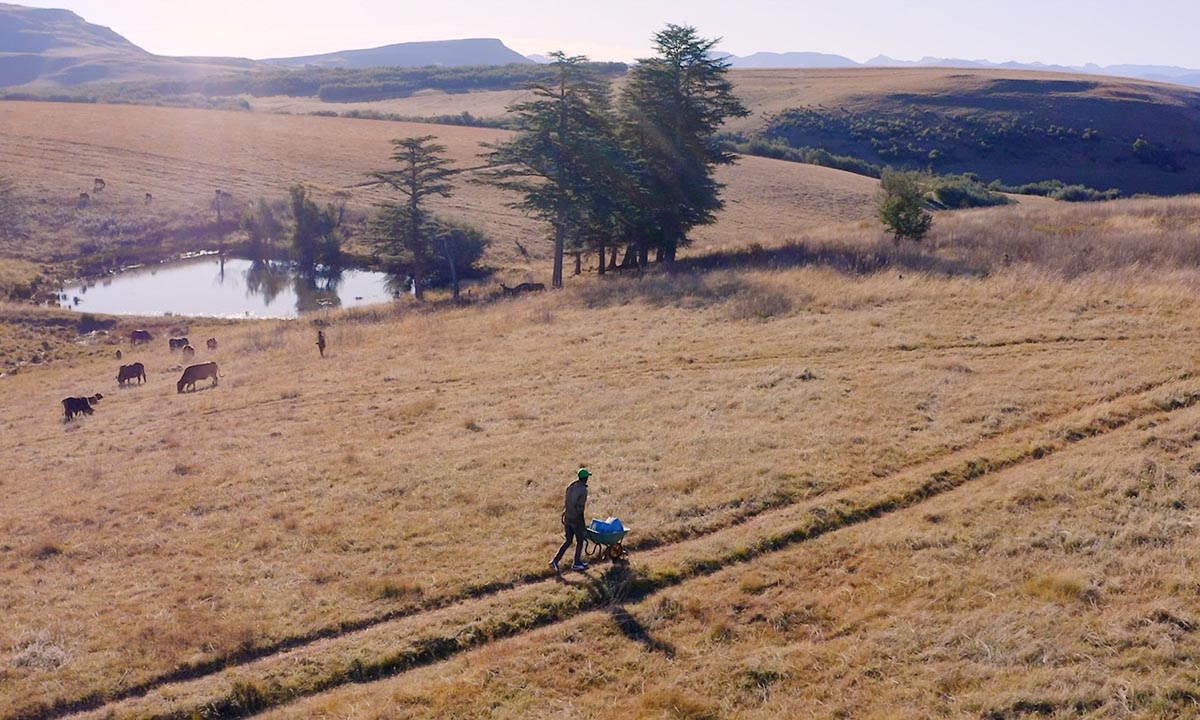
>12B
liters of water replenished
to local watersheds in 2023
Goals & progress
Achieving long-term improvements to high water-risk watersheds requires scale, partnership and engagement from all stakeholders in each of our locations. And given the uniqueness of each local watershed’s ecosystem, scaling our solutions can take time and significant resources.
In 2023, we made progress on our pep+ water goals:
- Recorded a 25% improvement in water-use efficiency at our high water-risk company-owned locations when compared to a 2015 baseline, reaching one of our 2025 goals two years ahead of schedule. As a result, we will no longer report on it. Instead, our reporting focus will shift to our work to become net water positive, including progress against our aggressive 2030 goals aimed at world-class and best-in-class operational water-use efficiency.
- Continued our efforts to strive toward best-in-class and world-class water-use efficiency by 2030.
- Replenished approximately 69% of the water used in our company-owned manufacturing facilities in high-risk watersheds, the equivalent of more than 12 billion liters of water.
- Completed the adoption of the AWS Standard at 27 facilities and had 59 facilities in the process of adopting at the end of 2023.
2025 Operational water-use efficiency goal
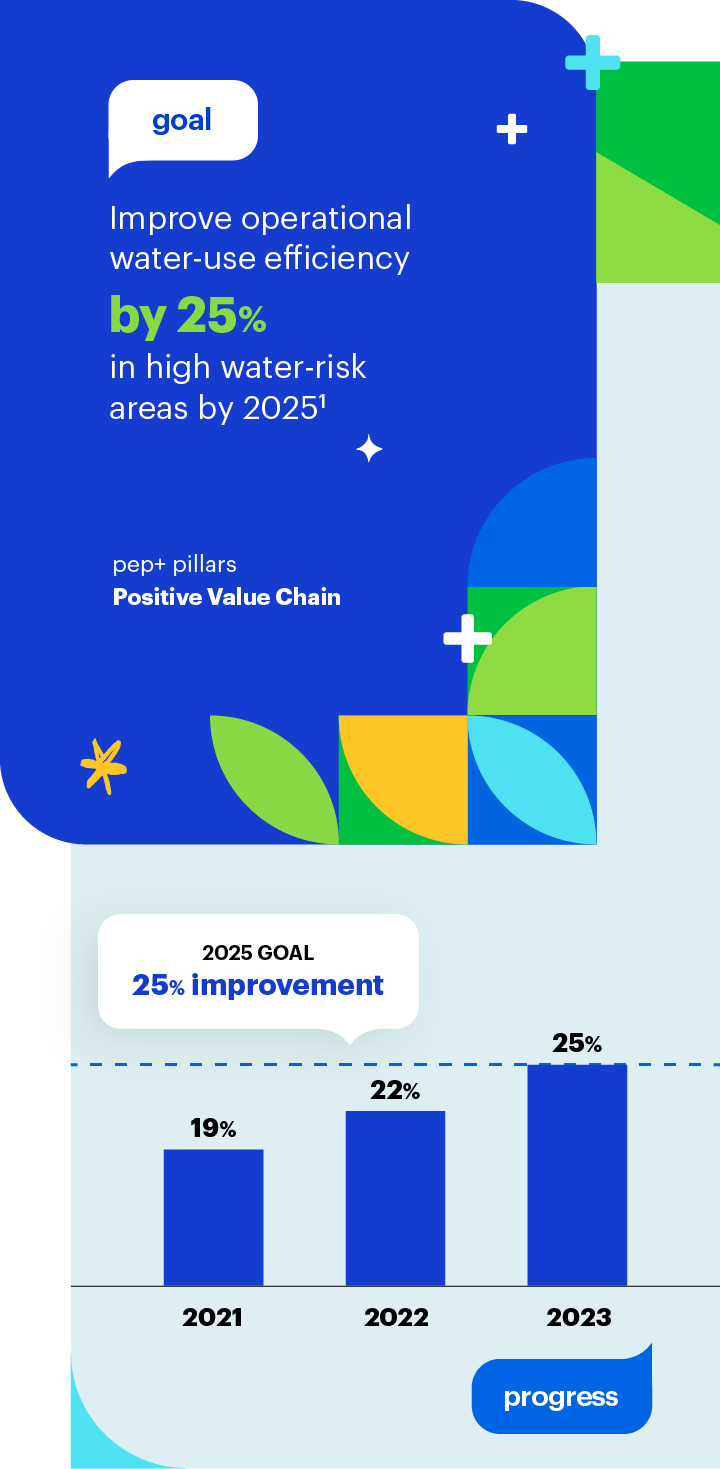
2030 Operational water-use efficiency goals

Local watershed replenishment goal
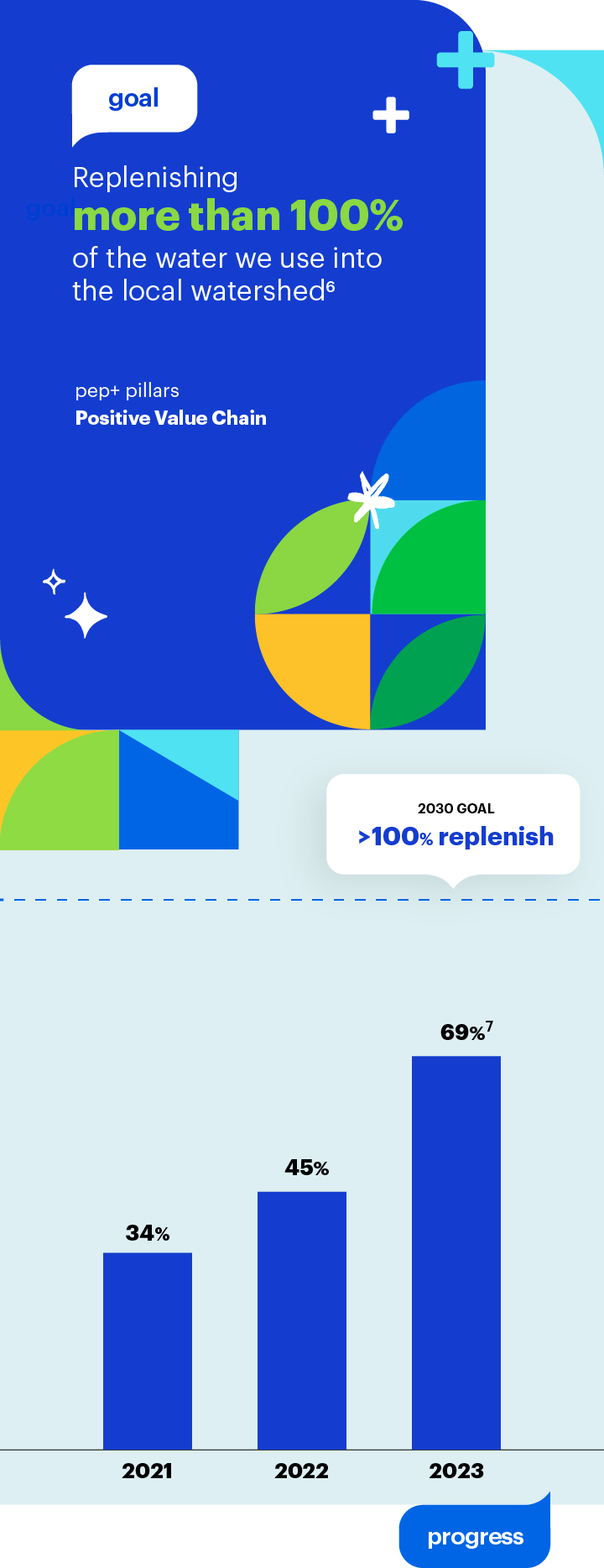
Water Stewardship Standard goal
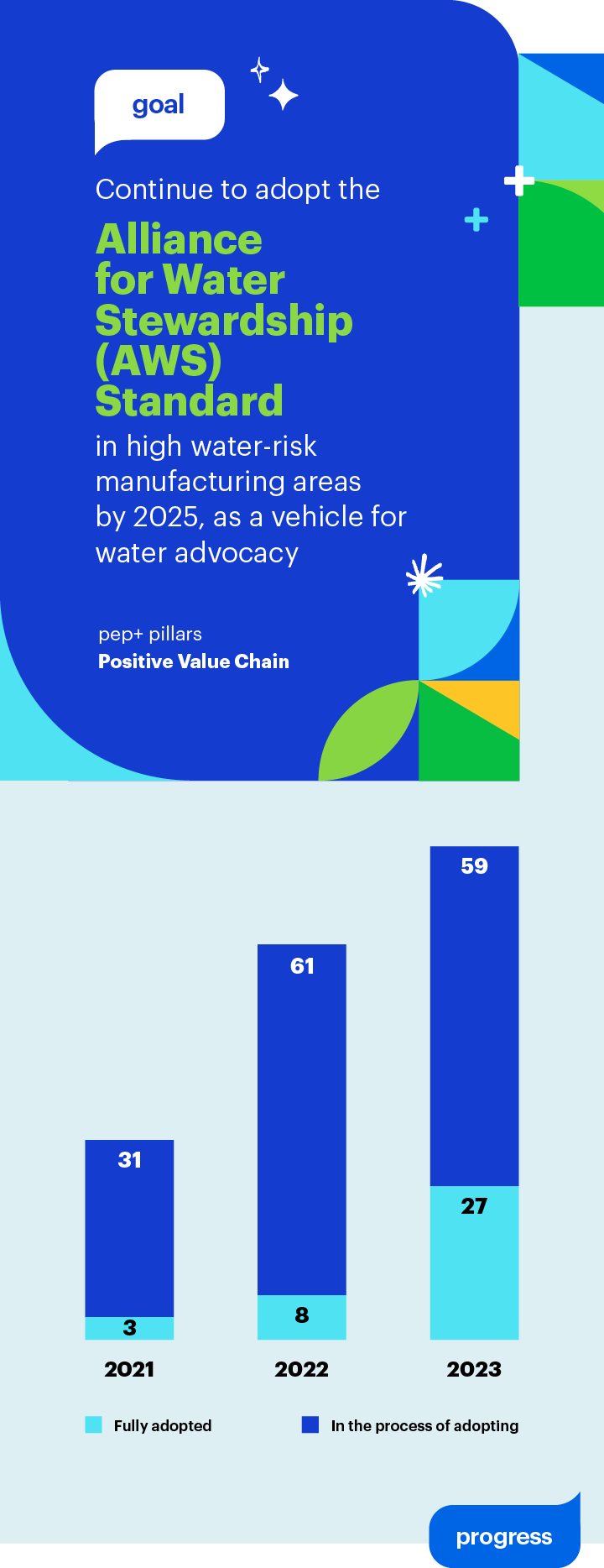
1. Measured versus a 2015 baseline. Results reflect the exclusion of third-party facilities. Between 2006–2015, water-use efficiency improved by 26% in global legacy operations at the date of target setting. World Resource Institute’s Aqueduct water stress assessment tool is used to reconfirm high water-risk areas every three years
2. Best-in-class water-use efficiency for convenient foods facilities is defined as 0.4 liters of water (or less) per kg of convenient foods production. We do not currently capture data from third-party manufacturers and are evaluating how to obtain and include information from our top third-party manufacturers in future calculations. World Resource Institute’s Aqueduct water stress assessment tool is used to reconfirm high water-risk areas every three years
3. Best-in-class water-use efficiency for beverage facilities is defined as 1.2 liters of water (or less) per liter of beverage production. We do not currently capture data from third-party manufacturers and are evaluating how to obtain and include information from our top third-party manufacturers in future calculations. World Resource Institute’s Aqueduct water stress assessment tool is used to reconfirm high water-risk areas every three years
4. World-class water-use efficiency for convenient foods facilities is defined as 4.4 liters of water (or less) per kg of convenient foods production. We do not currently capture data from third-party manufacturers and are evaluating how to obtain and include information from our top third-party manufacturers in future calculations. World Resource Institute’s Aqueduct water stress assessment tool is used to reconfirm high water-risk areas every three years
5. World-class water-use efficiency for beverage facilities is defined as 1.4 liters of water (or less) per liter of beverage production. We do not currently capture data from third-party manufacturers and are evaluating how to obtain and include information from our top third-party manufacturers in future calculations. World Resource Institute’s Aqueduct water stress assessment tool is used to reconfirm high water-risk areas every three years
6. 2030 goal tracks replenishment tied to company-owned and third-party facilities in high water-risk areas. World Resource Institute’s Aqueduct water stress assessment tool is used to reconfirm high water-risk areas every three years. The reported replenishment volumes for company-owned facilities are currently being capped at 100% per location. Once we achieve 100% for each company-owned location, we will start to then report progress of more than 100% replenishment. We do not currently capture data from third-party manufacturers and are evaluating how to obtain and include information from our top third-party manufacturers in future calculations
7. We continue to measure progress against our original 2025 goal and our extended 2030 goal. World Resource Institute’s Aqueduct water stress assessment tool is used to reconfirm high water-risk areas every three years. In 2022, an updated water risk assessment identified additional company-owned high water-risk facilities, which are in-scope for calculating progress against our 2030 goal only. Excluding these additional company-owned facilities water usage, we replenished 82% of water used in high water-risk facilities in 2023, representing progress against our original 2025 goal. See Calculation methodology on ESG Topics A-Z for additional details
Explore Water topics in more depth
PepsiCo's ESG Topics A-Z provides detail on strategy, data, policy, progress and more on a wide range of subjects.
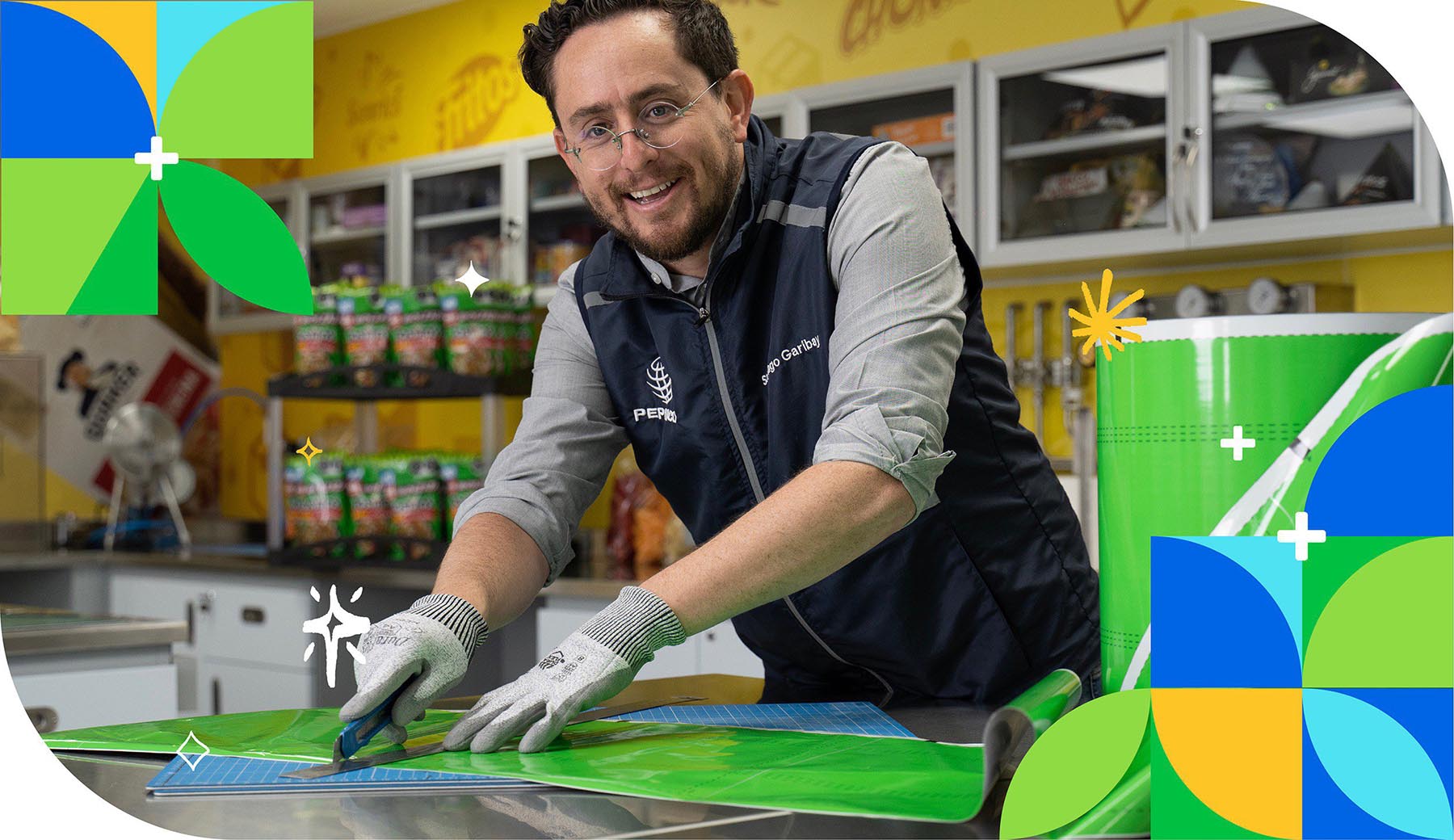
Packaging
PepsiCo's sustainable packaging approach is grounded in a vision to create a world where packaging never becomes waste.
We aim to reduce the amount of virgin plastic used in our packaging. As we look to achieve our ambitious packaging goals, our commitment to take action is steadfast. While our 2023 progress is trending in the right direction versus prior year, we’re mindful that opportunities remain to continue expanding and building upon our efforts and we’re always learning, evolving and investing strategically to meet our ambitions.
We also design our packaging to comply with food safety regulations while maintaining the freshness and quality of our products and with consideration to environmental sustainability, convenience and other consumer preferences.
However, no one company or industry can create a circular economy on its own. Sustainably managing our packaging requires comprehensive solutions, many of which are complex and hinge on significant systemic transformations such as infrastructure, policy or consumer engagement. To address this global issue, we are working together with our stakeholders, including governments, NGOs, suppliers, customers, peer companies, consumers and more, to find scalable solutions. To achieve these transformations, multi-stakeholder collaboration and action-oriented partnerships across the entire packaging value chain are needed.
This will not only help us, but also further help build a circular economy for packaging that benefits us all.
Amongst a number of ways that PepsiCo is lending its voice to influence the necessary systems change, is our engagement as a member of the Business Coalition for a Global Plastics Treaty. Through the coalition we advocate for an ambitious UN global agreement to end plastic pollution. We believe a global treaty that creates a common framework with legally binding rules for national action has potential to spur significant progress toward a circular economy for packaging. PepsiCo supports action across the value chain in the areas of reduction, circulation and prevention. More specifically, we believe the treaty could deliver benefits through aligned definitions and metrics, agreement on measures to improve packaging design and improved waste management systems, including smart extended producer responsibility (EPR) policies based on industry aligned principles, among other provisions.
Our sustainable packaging vision
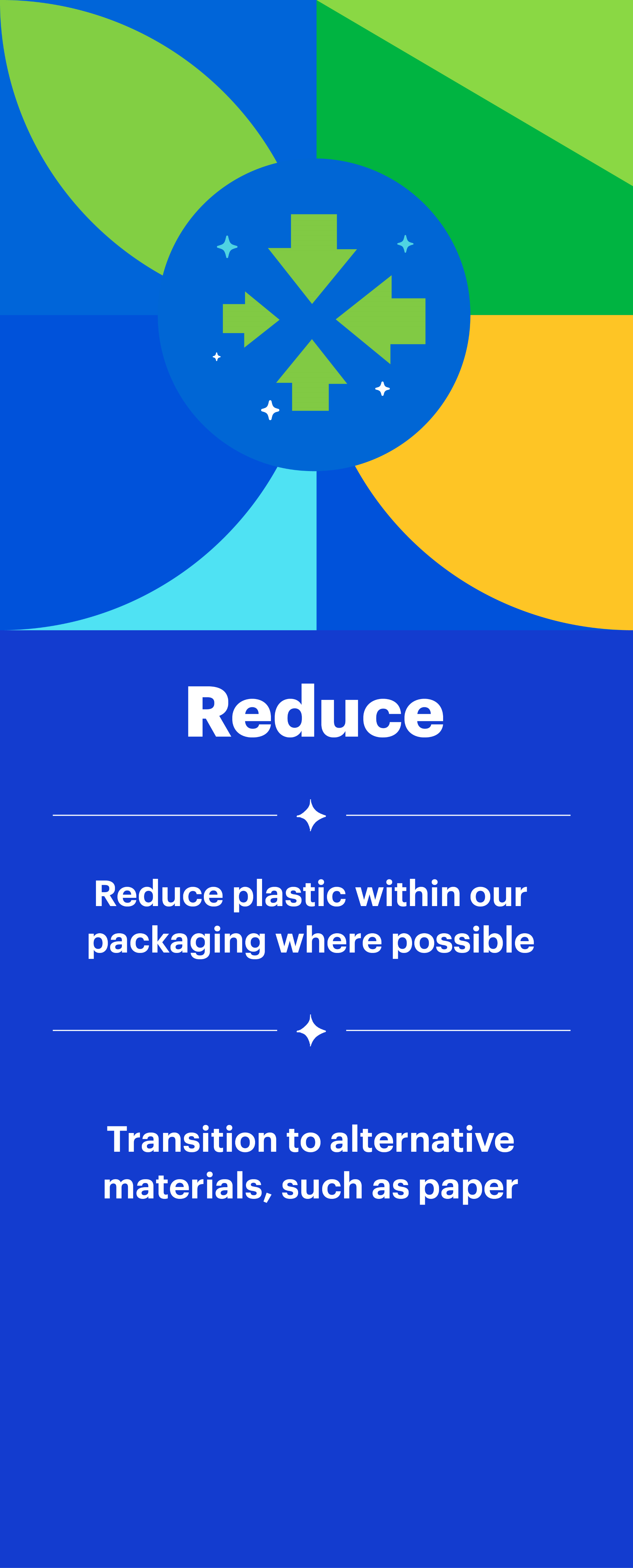
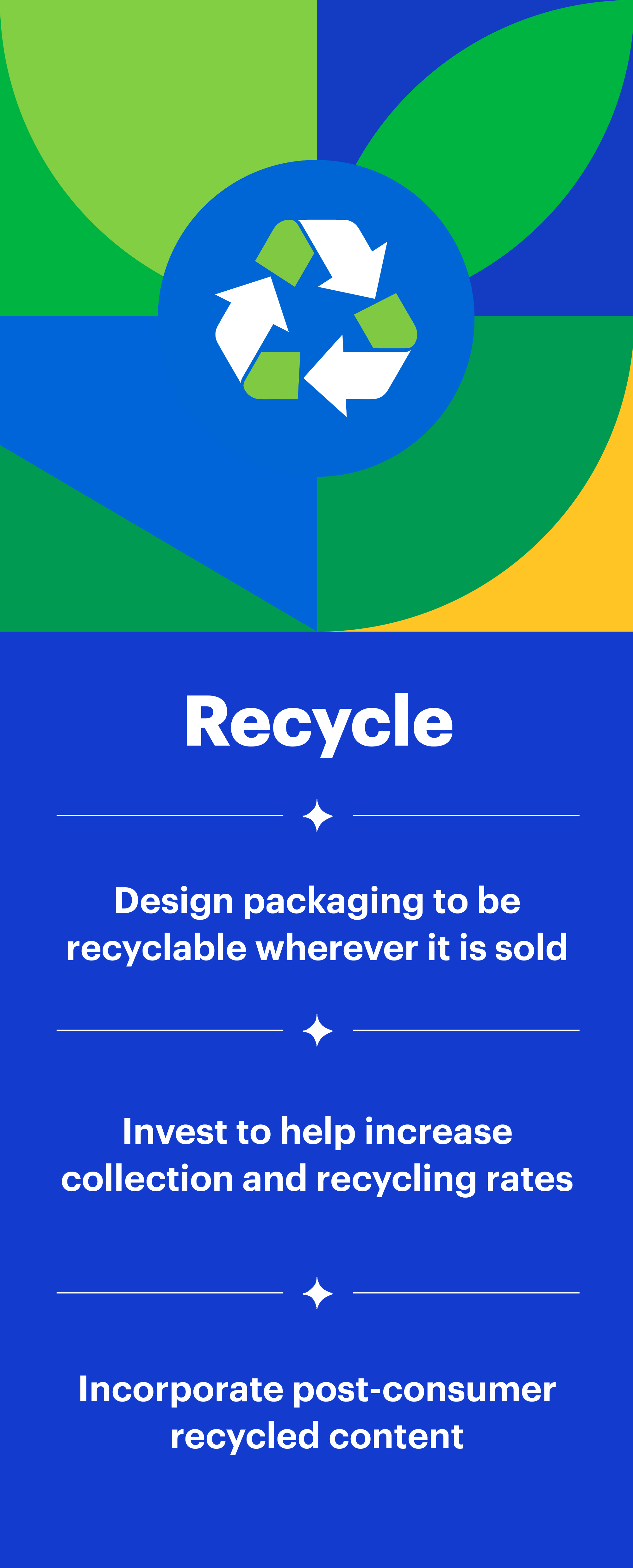
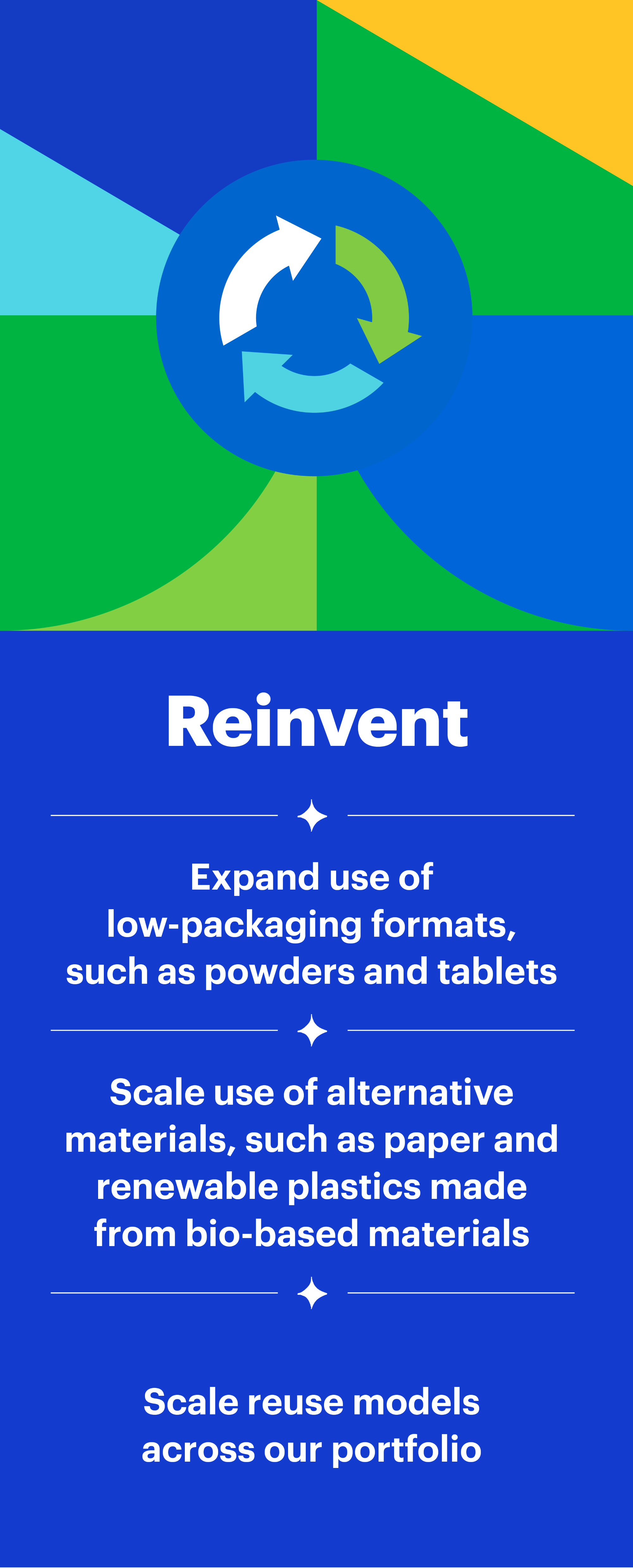
Approach
We are working to make our value chain more circular and to tackle significant global challenges related to packaging through innovation, policy advocacy and infrastructure investment.
Our three-pronged strategy (Reduce, Recycle and Reinvent) is designed to help our aim to drive progress toward our pep+ goals.
Reduce
To meaningfully address our use of plastic packaging and help drive progress toward our goal to reduce absolute virgin plastic from non-renewable sources by 20% by 2030,1 we seek to lightweight our packaging and find opportunities to transition to alternative materials, such as paper. In 2023, we accomplished the following concerning plastic across our packaging:
- Became the first beverage company to announce a North American roll out of paper solutions to replace plastic rings on all beverage multipacks.
- Continued efforts to reduce head space in packaging.
Recycle
We’re focused on further improving the recyclability of our packaging — both by incorporating more recycled content into our packaging and developing, funding and advocating for infrastructure solutions that further enable the collection and recycling of our packaging.
We acknowledge that this work does not come without its challenges for companies and society. Building sufficient collection, sortation and waste management infrastructure, as well as well-designed policies that support a circular economy, are significant challenges we and others face.
Significant changes are needed to address broader infrastructure, particularly in recycling and reuse systems to ensure packaging has the right end of life. We’ll continue to engage externally and across industries to collaborate on the essential shifts needed to support this transformation.
Despite the challenges, we’ve made several changes to our packaging to reduce plastic usage and enhance the recyclability of our products, such as transitioning to mono-material paper cups for our Rice-a-Roni and Quaker Porridge pots in the U.K.
We’re also incorporating recycled polyethylene terephthalate (rPET) into the packaging we use within our beverages portfolio. In 2023:
- More than 60 markets had at least one PepsiCo product with rPET in beverage packaging. For example, Pepsi bottles in Uzbekistan are now made with 20% rPET as a result of a new recycled food-grade plastic introduced in the International Beverages Tashkent bottling partner factory — making PepsiCo the first beverage company to use rPET in the country.
- More than 30 markets had at least one PepsiCo product with 100% rPET (excluding caps and labels) in its packaging. For example, Pepsi Black in India became the first carbonated beverage to market with a 100% rPET bottle after the country’s decision to permit its use in food and beverage applications.
We have also prioritized investments in sustainable packaging solutions and partnerships across the value chain. In 2023, we launched 50% recycled content2 into our Sunbites packaging in the U.K. Several partners from across the flexible food packaging supply chain, including GreenDot, have worked together turning what was once plastic waste into food-grade packaging material, with the potential to eliminate 200 metric tons of fossil-based plastic across Sunbites packaging by the end of 2025.
To help meet our recycled content ambitions, we work with a variety of partners to drive improvements to collection and recycling systems and continue to invest in infrastructure that will provide greater accessibility to consumers who wish to recycle.
- PepsiCo, along with other leading U.S. beverage companies, is part of the Every Bottle Back initiative in the U.S., which has collectively invested just over $25 million in community recycling infrastructure upgrades to collect bottles that can be made into new ones. Investments made in 2023 as part of this initiative are expected to bring more than 800 million pounds of new recyclables into the recycling stream, including more than 30 million pounds of PET and more than 10 million pounds of aluminum.
- We have helped set up a voluntary EPR program for the collection and reuse of flexible packaging in Thailand. The program, Journey to Zero Waste, collected 1,000 metric tons of flexible films in 2023.
- We engage proactively with governments that intend to establish Deposit Return Systems (DRS) for beverage containers in order to increase PET collection rates. For example, in 2023, we were among the companies that initiated and invested in a well-designed DRS in Romania, which is expected to increase recycling rates.
- PepsiCo helped launch the first packaging producer responsibility organization (PRO) in the U.S., Circular Action Alliance (CAA). As a formal PRO approved to implement EPR programs in Colorado and California, CAA aims to deliver harmonized best-in-class compliance services, scale innovation and build systems that help both companies and consumers waste less and recycle more. PepsiCo holds board seats at both the national and state-level and supports the implementation of well-designed EPR programs in the U.S.
Reinvent
Our reinvention efforts focus on improving the environmental impact of our packaging through the use of alternative materials, such as non-plastic and compostable options, as well as scaling reuse models and low-packaging formats. Central to this approach are working closely with partners to promote sustainable practices and accelerating innovation throughout the packaging value chain.
In 2022, we set a goal of having 20% of our beverage servings sold in reusable models by 2030.3 This target supports our drive for innovative packaging solutions and delivery models that can help us reduce our use of virgin plastic per serving, decouple business growth from virgin plastic use and, over time, decrease GHG emissions. As of 2023, 10% of our beverage servings are sold in reusable models.4
Throughout 2023, we continued accelerating our efforts. For example, we:
- Trialed paper for secondary packaging of multi-serve packaging of Walkers Baked in the U.K.
- Opened the doors to the Greenhouse Learning Center in Plano, Texas, a first-of-its-kind facility dedicated to advancing progress on compostable packaging.
- Continued to invest in returnable bottles with program expansions in Mexico and implemented a universal bottle across our beverage brands in Spain. As of the end of 2023, we have returnable bottle programs in more than 75 international markets.
- Expanded our SodaStream portfolio through the launch of two new models (E-Terra and E-Duo) and automated refill program for CO2 canisters to further improve consumer convenience and customization.
- Piloted a reusable cup solution in Baltimore, Maryland in partnership with TURN, featuring gamification to incentivize consumers to return their fountain beverage cups after use.
- Eliminated more than 15,000 disposable cups at the Union of European Football Association (UEFA) Champions Festival in Istanbul through a reusable cup initiative, in partnership with TURN.
PepsiCo is leveraging partnerships to identify reuse solutions within the value chain and advocate for smart policies. For example, in 2023, we continued engagement with the NextGen Consortium, a multi-year industry collaboration with Closed Loop Partners, working to reimagine foodservice packaging including accelerating learnings and action on reusable cups. Together, we are striving to develop reuse and refill models that will inspire consumers and drive reuse growth. We also joined the Consumer Goods Forum Reuse/Refill Workstream, partnering with peer companies and retailers to move beyond pilots toward scaled reuse solutions.
We know that transforming the traditional beverage consumption model will require a holistic approach on the part of industry, consumers, retailers and government. While this starts with making reuse and refill options accessible and convenient at scale for consumers, industry efforts are only one piece of a complex puzzle — we will need all parties to take action.
We regularly engage with policymakers and stakeholders throughout the value chain with the goal of ensuring a broad definition of reuse models is adopted and incentivized to scale, as we have been doing during the policy process leading to the finalization of the European Union’s Packaging and Packaging Waste Directive (PPWR). We’re actively engaged with industry platforms such as Ellen MacArthur Foundation and the World Economic Forum’s Consumers Beyond Waste to scale reuse models and align on standardized measurement methodology.
We know working toward more sustainable packaging solutions is a complex endeavor, one that will require collaboration from federal, state and local governments, the private sector and NGOs. This, coupled with an effective and well-designed policy framework, will help us progress toward a more circular economy. PepsiCo is supportive of global action and is dedicated to being part of the solution.
1. Measured versus a 2020 baseline
2. Recycled plastic content allocated using the International Sustainability and Carbon Certification Plus (ISCC+) certified mass balance approach
3. Our total beverage servings account for all beverage sales volume. Reuse models may include, but are not limited to, SodaStream, fountain beverages delivered in reusable containers, returnable glass and plastic bottles, and concentrates and powders sold to consumers
4. Fountain beverages delivered in reusable containers requiring third-party data are not currently measured
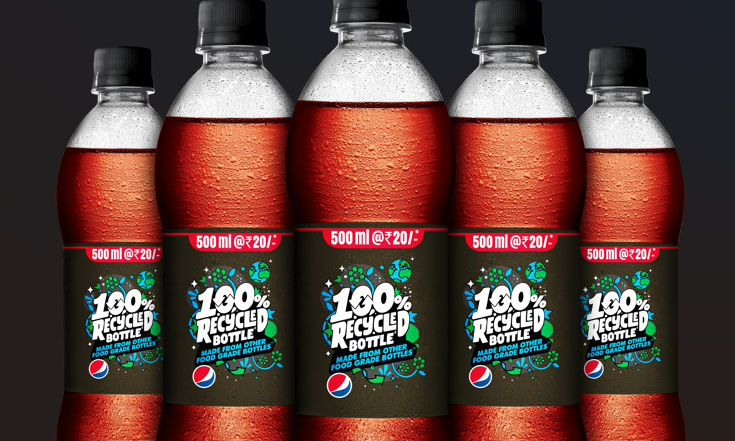
30+
markets offer at least one product
with bottles made from 100% rPET1

80+
global market offer reuse solutions
such as returnable bottles and SodaStream

Goals & progress
While achieving our packaging goals comes with a unique set of challenges to overcome, we continued to work toward our ambitions in 2023.
Given those challenges, we currently project that, by 2025, we will have designed 98% of our packaging to be recyclable, compostable, biodegradable or reusable (RCBR)1 and that 92% of our packaging will be overall RCBR—that is, both designed to be RCBR and RCBR based on availability of end of life solutions. This current projection has us short of our 100% goal, but, we continue with our ambition to innovate, invest and partner to progress further.
Recyclable, compostable, biodegradable or reusable goal
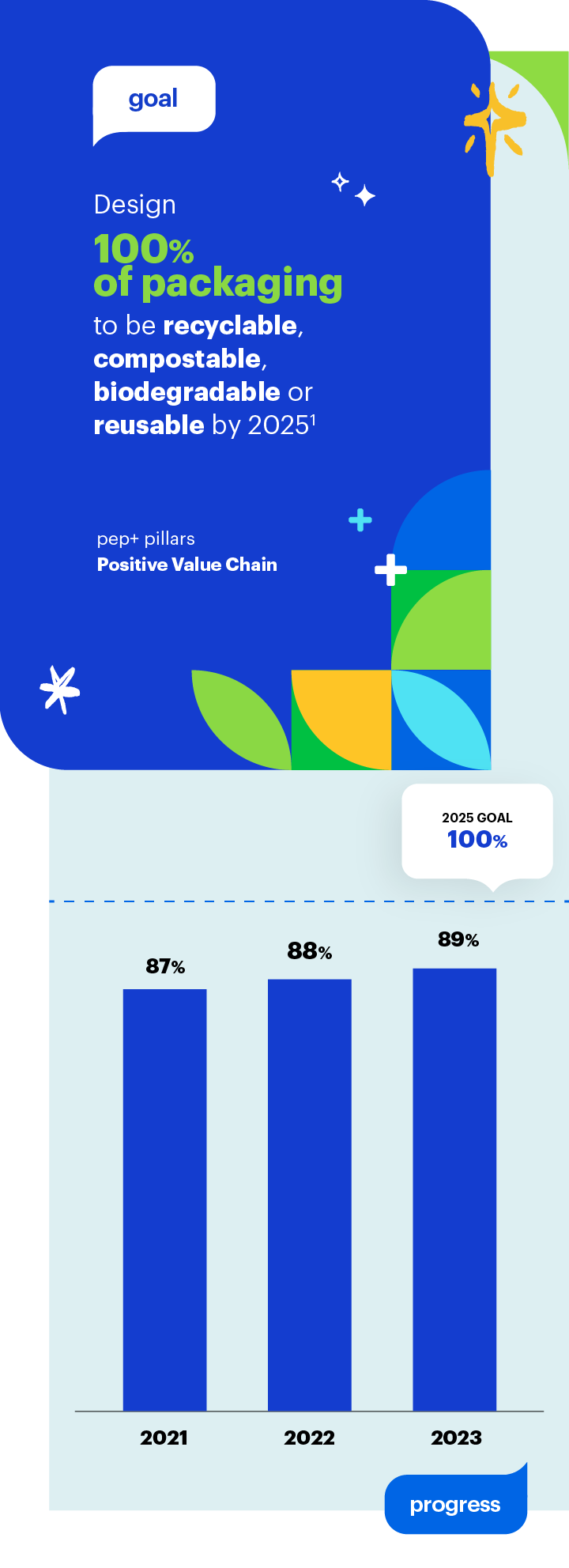
Recycling rate goal
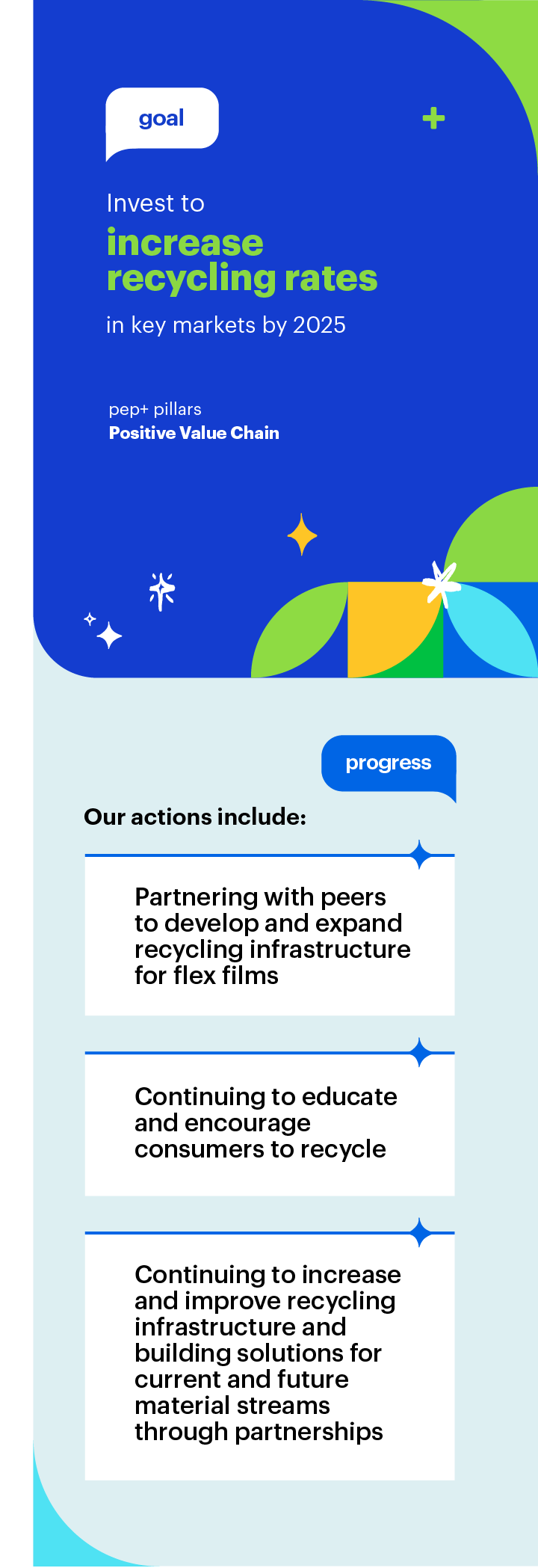
Per serving non-renewable virgin plastic reduction goal
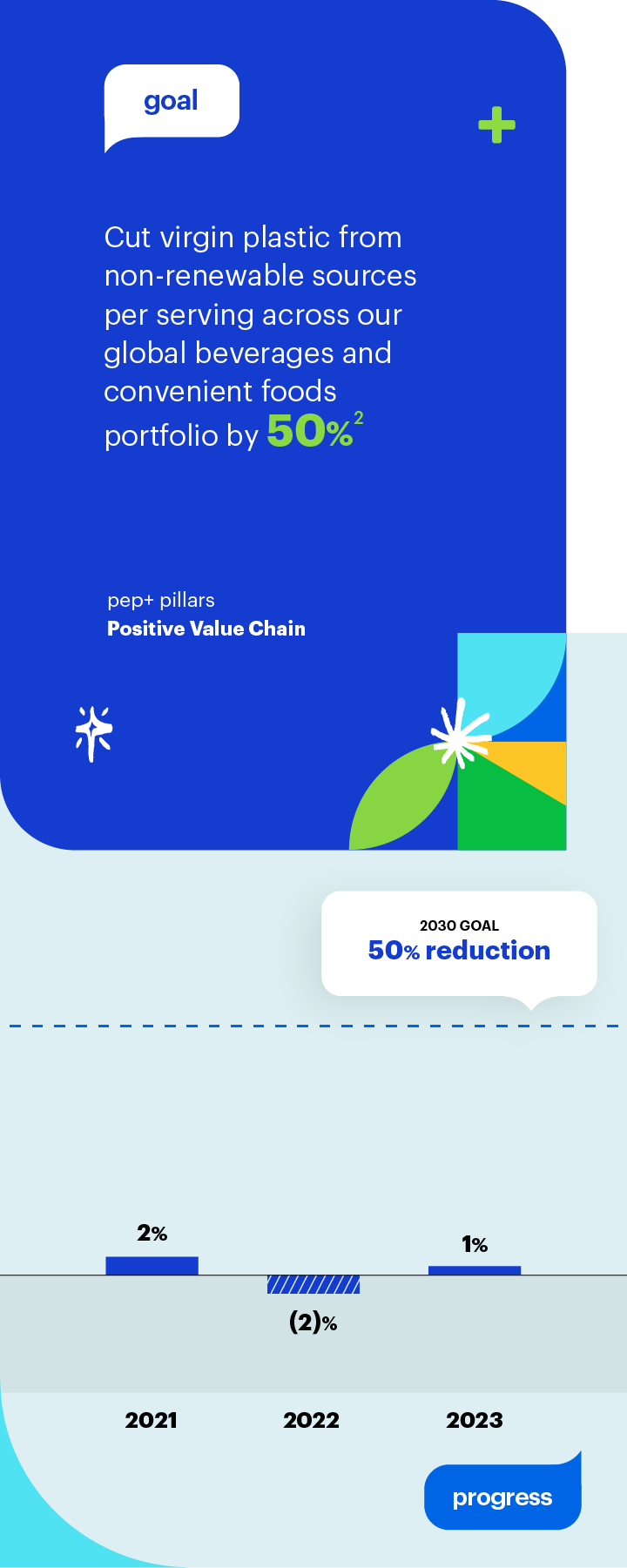
Scaling new business models goal
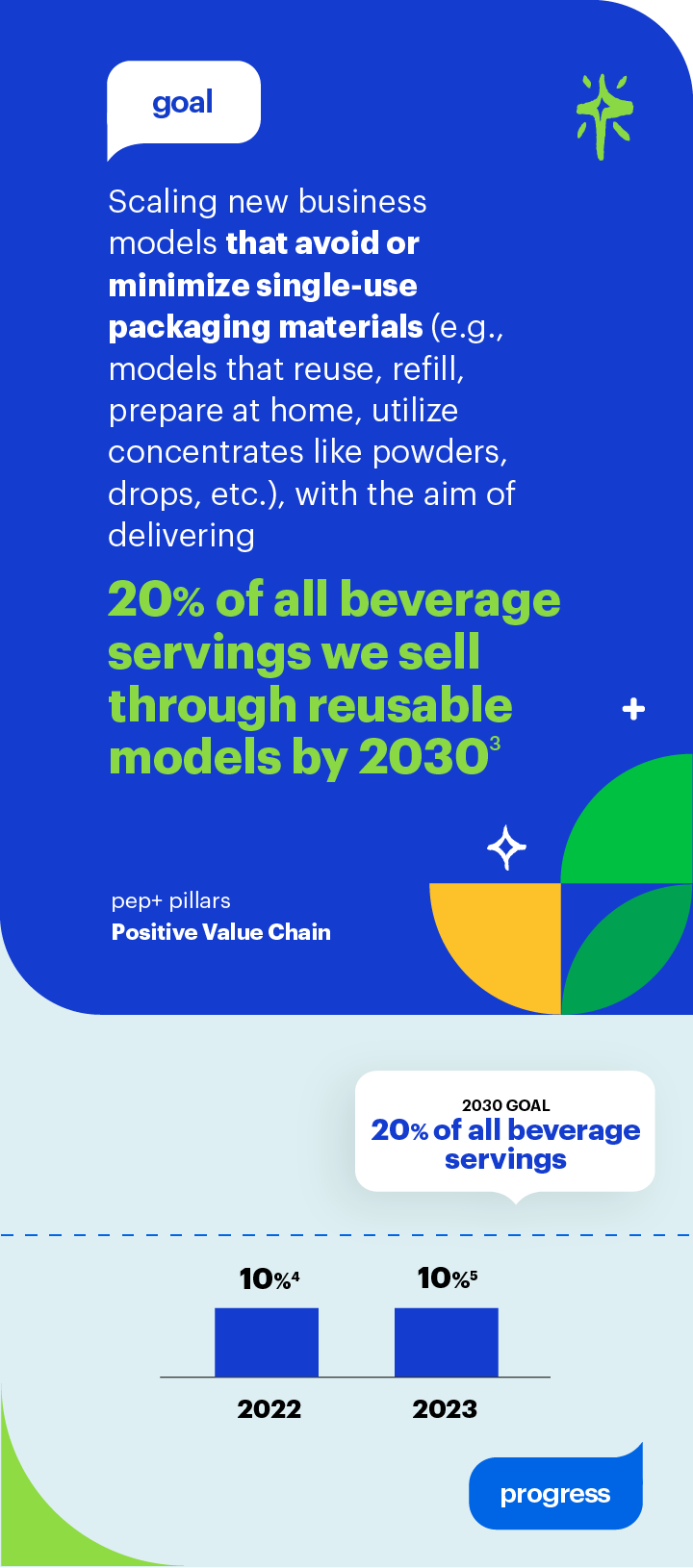
Absolute non-renewable virgin plastic reduction goal
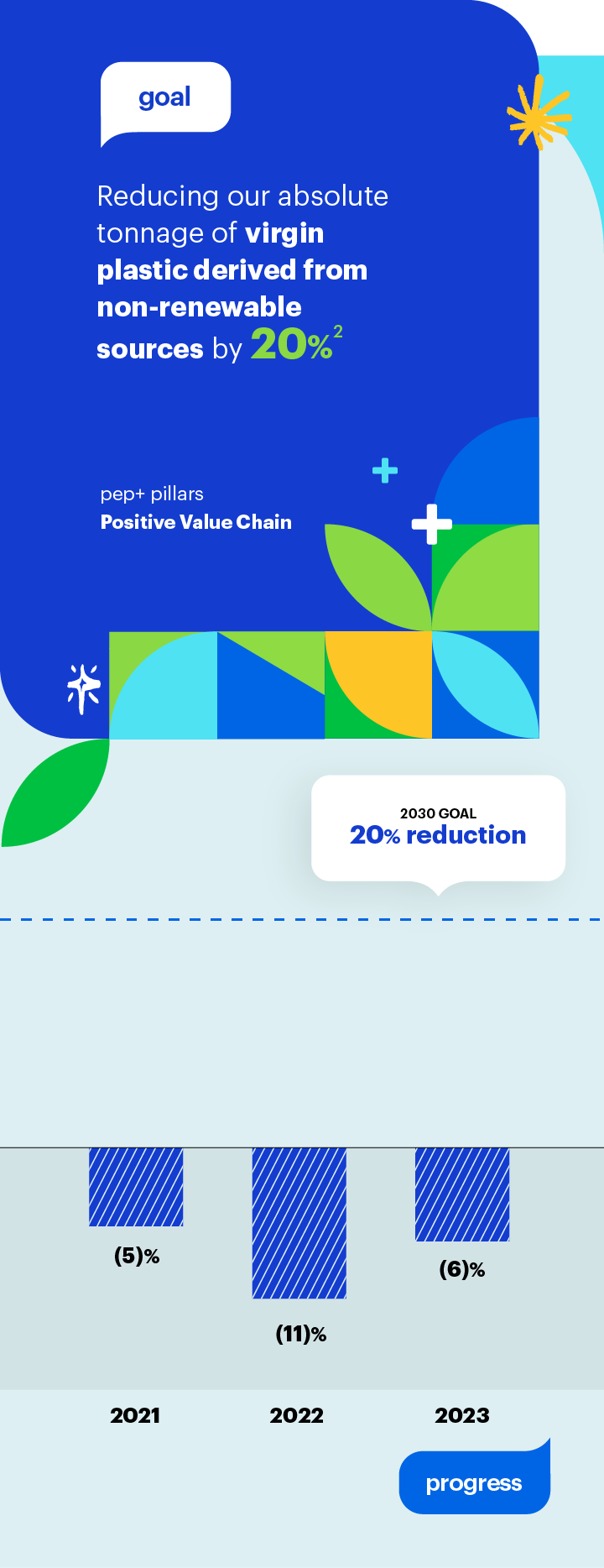
Alternative materials goal
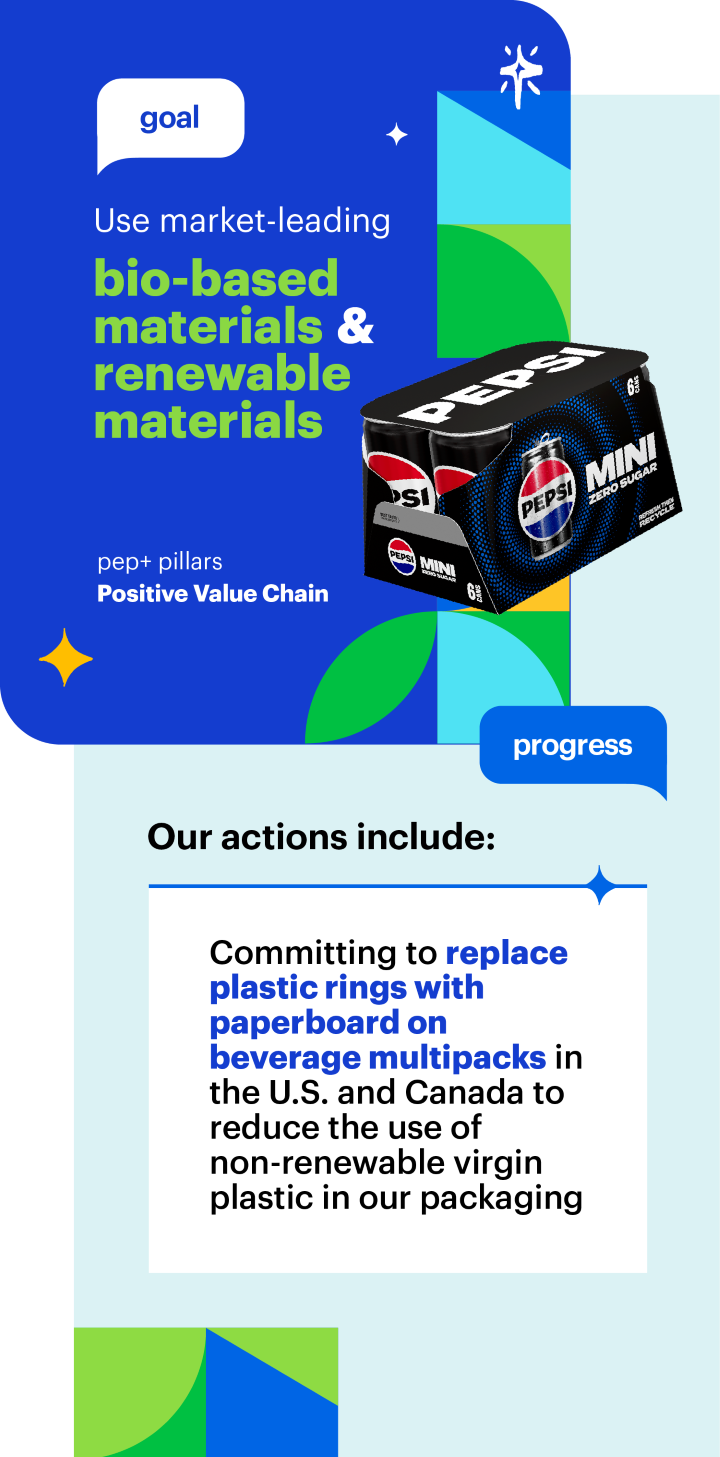
Increase recycled content goal
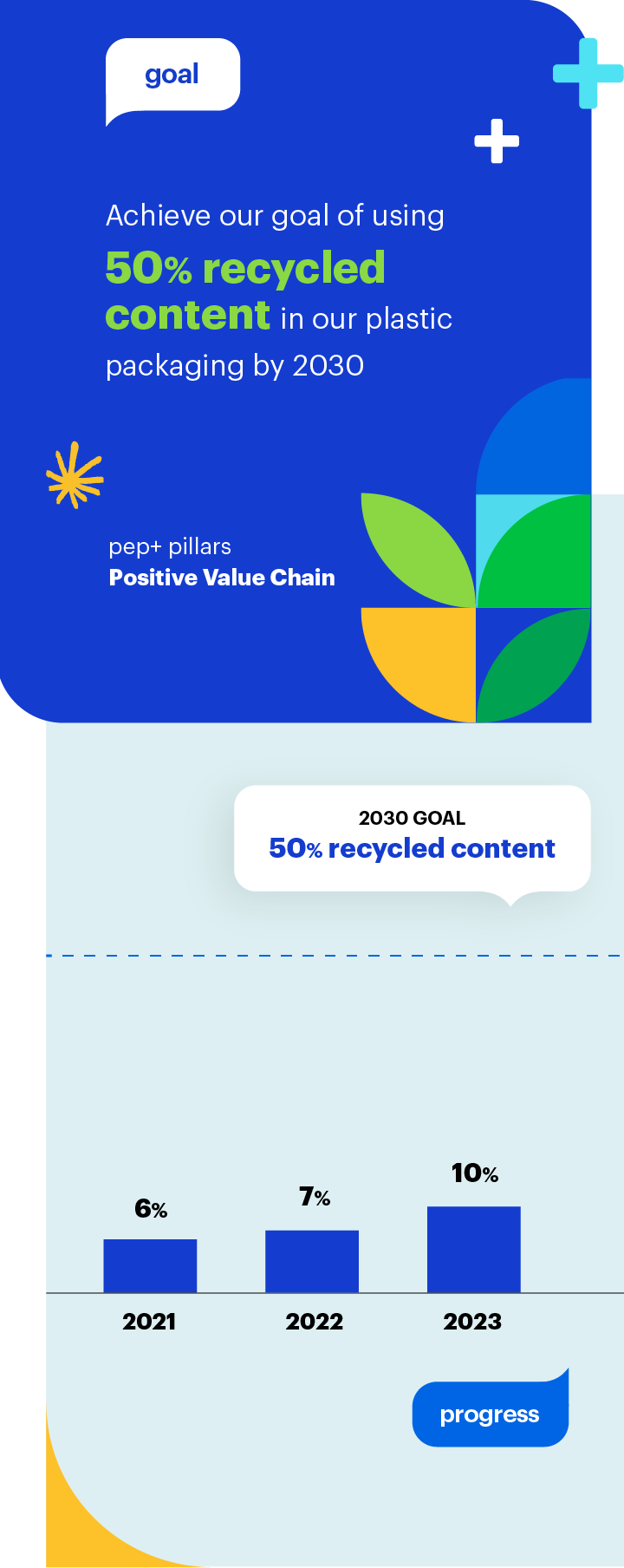
1. PepsiCo considers packaging to be recyclable, compostable, biodegradable or reusable (RCBR) if certain end-of-life waste management criteria is achieved. See Calculation methodology on ESG Topics A-Z for an explanation of how we calculate the percentage of our packaging that is RCBR
2. Measured versus a 2020 baseline
3. Our total beverage servings account for all beverage sales volume. Reuse models may include, but are not limited to, SodaStream, fountain beverages delivered in reusable containers, returnable glass and plastic bottles, and concentrates and powders sold to consumers
4. At the time we announced our new reuse goal, we estimated that approximately 10% of our beverage servings were already in reusable packaging. Fountain beverages delivered in reusable containers requiring third-party data are not currently measured
5. Fountain beverages delivered in reusable containers requiring third-party data are not currently measured
Explore Packaging topics in more depth
PepsiCo's ESG Topics A-Z provides detail on strategy, data, policy, progress and more on a wide range of subjects.
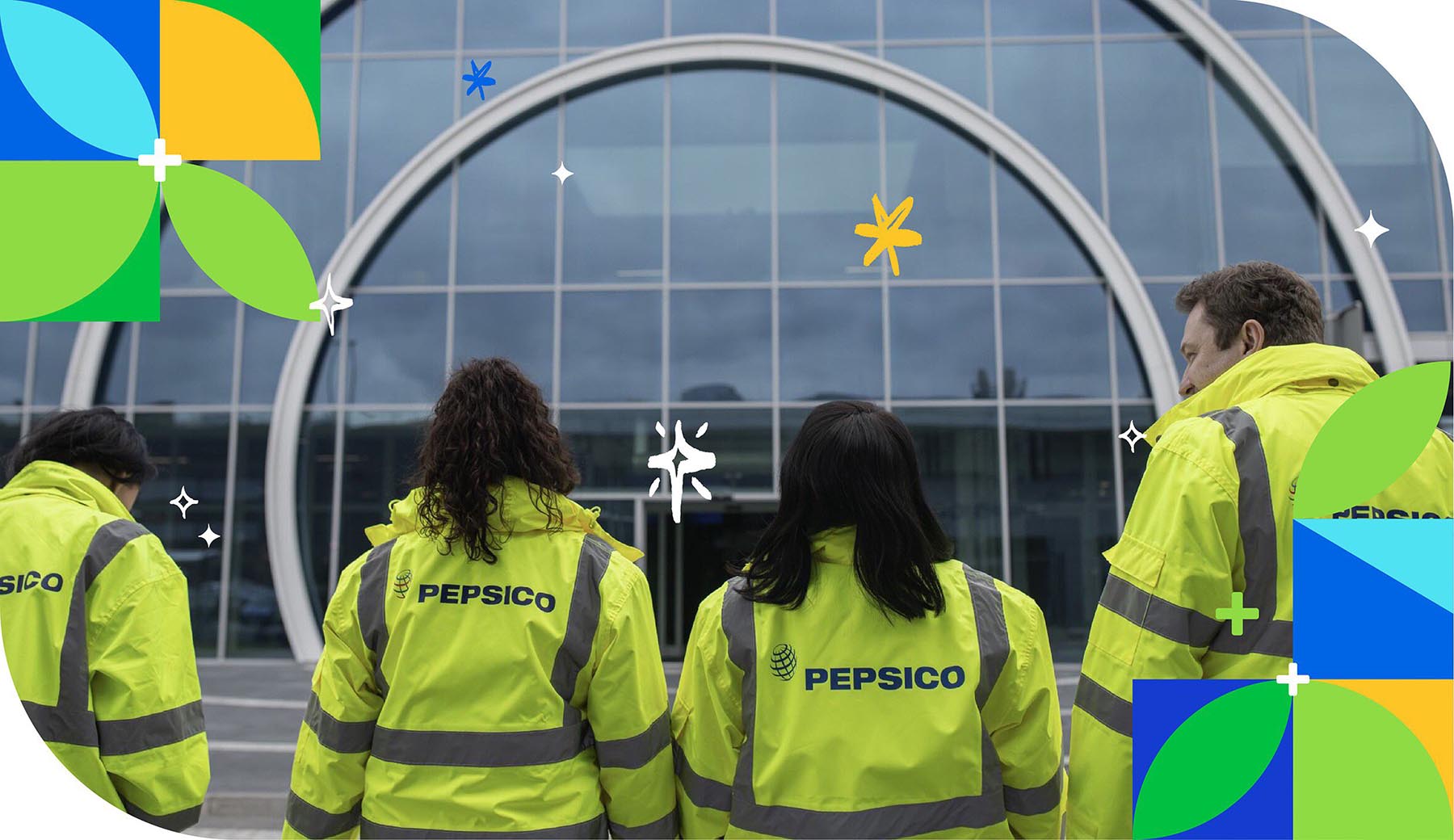
People
Prioritizing people and their experiences is critical to the overall success of our business. We are actively working to foster an engaging workplace culture; support the inclusivity of our teams; promote equity within our company and, where possible, reduce inequalities across our supply chains and throughout our communities, as we champion human rights.
Our positive impact on people

Approach, goals & progress
We focus on providing meaningful job and growth opportunities so our people are better positioned to make positive impacts at work, at home and in their local communities.
Approach to job and volunteer growth opportunities
In 2023, more than 11,000 employees volunteered more than 163,000 hours around the globe through One Smile at a Time, our internal global volunteering program.
Programmatic highlights that contributed to our pep+ employee volunteering goal in 2023 included:
- Nearly 700 employees volunteered and packed more than 65,000 meals and food packages which were donated to local food banks and feeding programs through a series of PepsiCo Foundation Holiday Hunger meal packing events across six different countries, in partnership with local nonprofits organizations.
- Employees from Egypt, Iraq, Lebanon, Pakistan, U.A.E. and Saudi Arabia distributed 1.1 million meals to vulnerable children and communities in the region as part of the “Filling Hearts Outside the Box” campaign.
- Employees in Mexico created more than 2,000 volunteering activities and volunteered more than 58,000 hours to positively impact their communities through activities such as cleanup, restoration projects and food packing events.
We also provide opportunities for employees to learn, grow and engage at work. Examples include:
- PEP U Degreed, an online, self-service platform that leverages artificial intelligence and machine learning to suggest personalized resources based on skill level, interests, colleague connections and learning habits. Course topics include giving feedback and cross-culture collaboration. In 2023, employees completed more than 1.5 million hours of learning.
- myEducation, which offers tuition-free learning opportunities for all U.S. employees through targeted programs and personalized coaching, is funded by PepsiCo. Based on internal data, participants in those programs are nearly two times more likely to advance in their careers. Since the program’s inception in 2022, more than 3,000 employees have enrolled and in 2023, more than 450 employees completed a degree or program.
- myDevelopment, PepsiCo’s internal talent marketplace, identifies internal opportunities that align with participating employees’ long-term PepsiCo career paths, considering their skills, interests and goals. In 2023, nearly 700 projects were created in the marketplace and more than 300 employees were assigned to and took part in short-term projects or new opportunities.
Job growth goal

Volunteer growth goal

Advance equality, inclusivity and human rights for our people, across our communities, so that together we can envision a better workplace and world.
Approach to managerial representation in the U.S.
We aim to increase representation at the manager level to reflect the workforce availability of the communities where we operate. To do so, we are expanding our recruitment pipeline to be more inclusive while providing training opportunities for our employees.
Programs like our Kickstart Sophomore Leadership Program help us identify potential talent while providing college students exposure to a career at PepsiCo. Since launching in 2021, over 200 students have participated in the 5-week leadership development program.
As we continue to build more inclusive leaders, since 2019 more than 27,000 PepsiCo employees have completed our Inclusive Leadership Training and since 2020 approximately 30,000 PepsiCo employees have completed our Unconscious Bias course.
Managerial representation in the U.S. goals
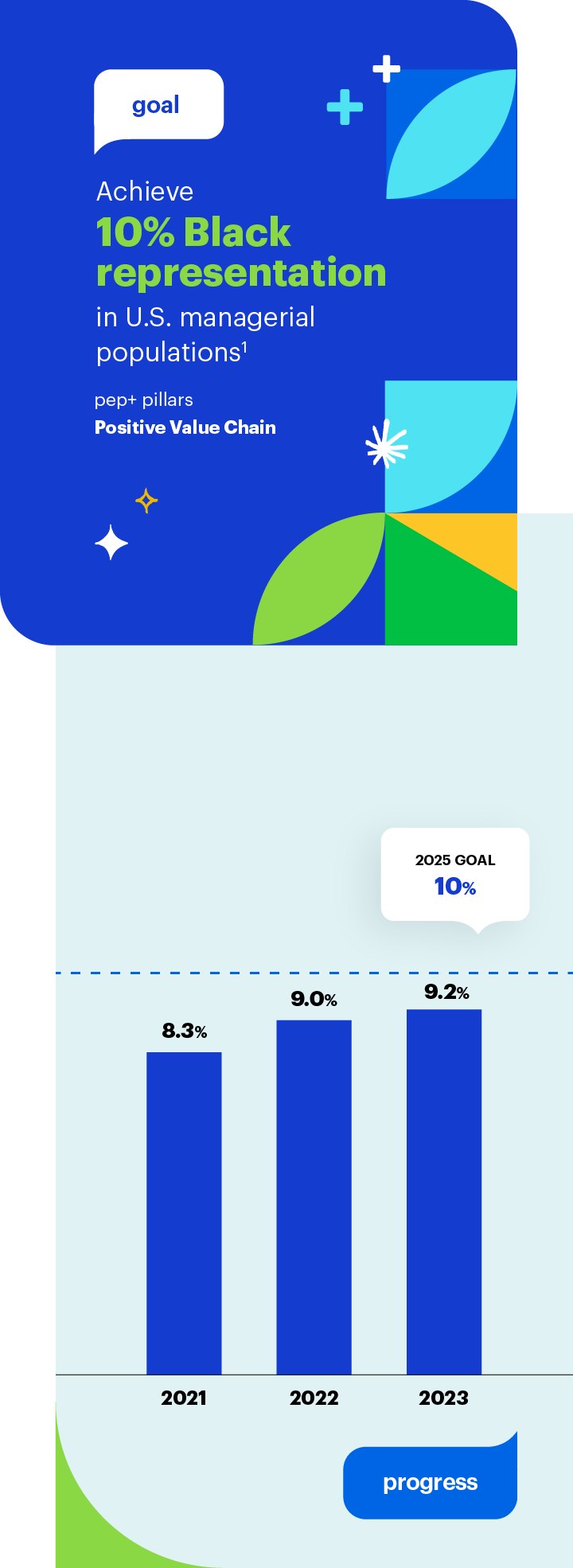
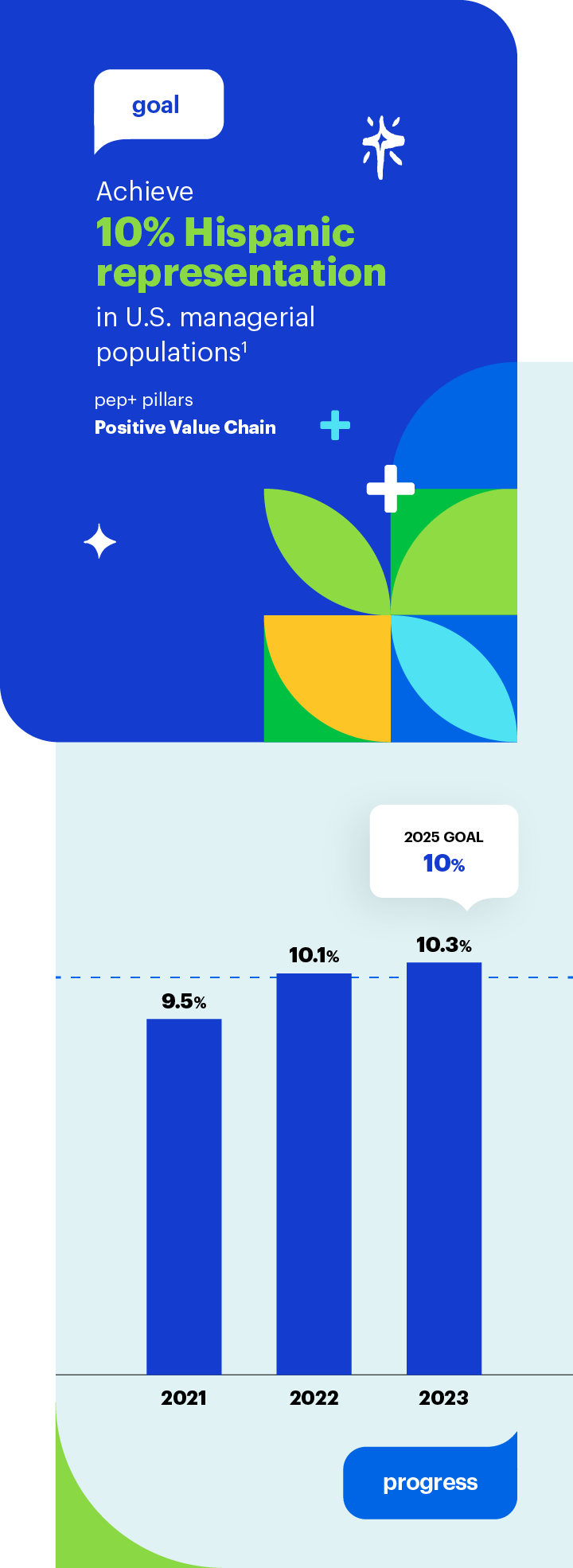
1. To reflect workforce availability of the communities where we operate
Approach to helping to address inequalities
Across our organization, we’re fostering a collaborative, equitable and inclusive culture where our people can bring their full selves to work, our business partners are set up for success and our communities can thrive. Specifically, we’re:
- Creating a space for employees to bring their full selves to work by seeking to understand the various identities of our employees. In 2023, we expanded our Global Self ID program so that employees around the world can voluntarily disclose aspects of their identity, as permitted by applicable law, such as their display name, pronouns, sexual orientation or gender identity, disability status or if they are a caregiver of an individual with a disability. In the U.S., employees can also disclose their military, veteran or military spouse status. By providing these options, we’re able to better respond to our employees’ needs with resources and benefits.
- Strengthening diverse owned businesses by developing relationships with a range of suppliers. This helps us build the world-class supplier base we need to succeed and strengthens mutually beneficial relationships that expand economic opportunity. Since 1982, when our Supplier Diversity program began, our annual volume of business with U.S.-based certified, diverse suppliers — Women, Black, Hispanic, Asian, LGBTQ+, Native American, Individuals with Disabilities and U.S. Veterans — has grown from an initial spend of $5 million to nearly $30 billion spent over the past 40 years.
- Creating access to economic opportunity through education by leveraging our reach and resources through the PepsiCo Foundation. Since 2021, more than 2,500 scholarships have been awarded to students across the U.S., progressing toward our goal to reach 4,125 students by 2025.
Reduced inequalities goal

Approach to gender parity in management
Women having equal access to employment and promotion is not only essential for a prosperous society, but also makes our company more innovative and competitive. Supporting women in building successful and fulfilling careers, while providing continued support through different stages of their lives and career paths is a key component of how we work toward gender parity. Following are examples of efforts that have helped us achieve 45% women in management roles globally in 2023.
- Offering career development programs: Our mentoring, coaching and development initiatives are tailored to various points throughout the employee life cycle. For example, INSPIRA is our multi-year talent development program in Latin America that offers tools, knowledge and experiences to accelerate the growth of managers, executive women and male allies. This engagement helps reduce turnover and build a gender-diverse talent pipeline.
- Expanding benefits: We enhanced life milestone benefits in the U.S. to include a family planning concierge service, a manager toolkit to improve support for new parents and an innovative benefit that helps ship breast-milk for nursing mothers who need to travel. We also launched a global menopause education campaign, along with new benefits to support women in perimenopause and menopause. We’re also expanding family building resources outside the U.S. (e.g., education, fertility, surrogacy and adoption support).
Additionally, to increase representation of our frontline employees, we launched She is PepsiCo, a campaign to spotlight women in manufacturing and operations in North America to inspire more women to seek opportunities in roles that are not at gender parity.
Gender parity goal
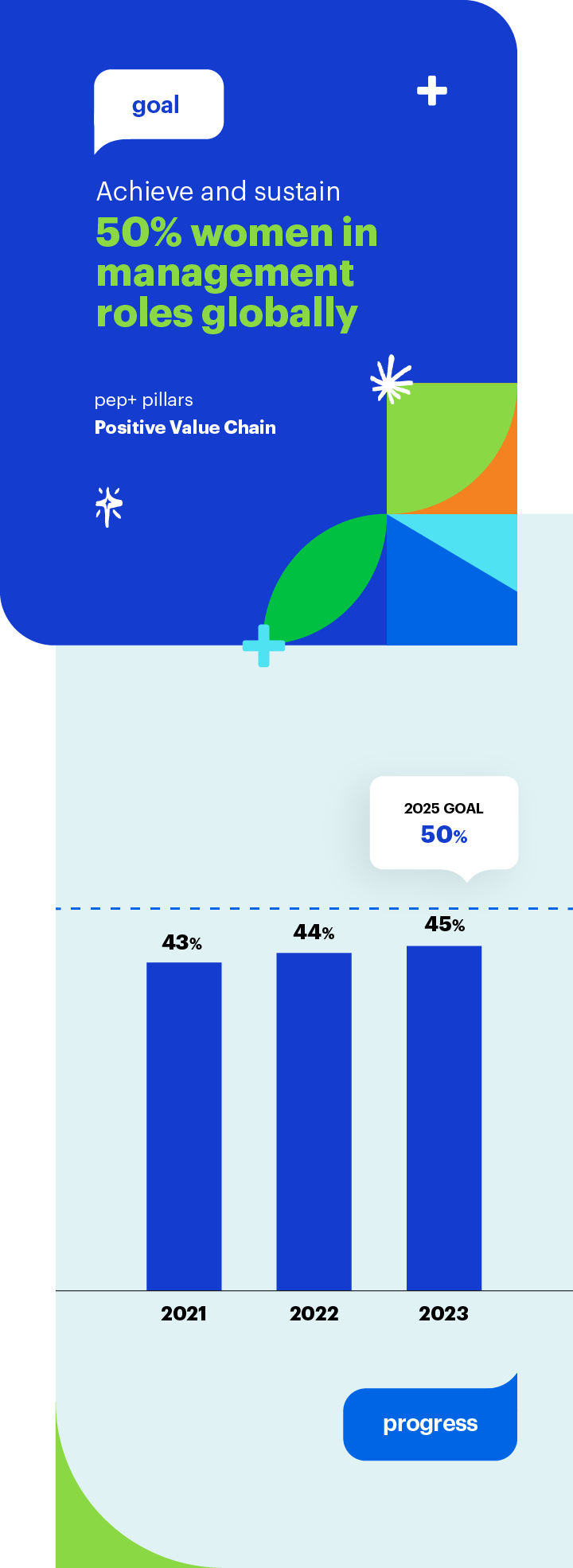
Approach to pay equity
Our aim is consistent and fair compensation throughout our workforce, considering legitimate drivers of pay, such as job level, geographic location and performance ratings.
Pay equity goal
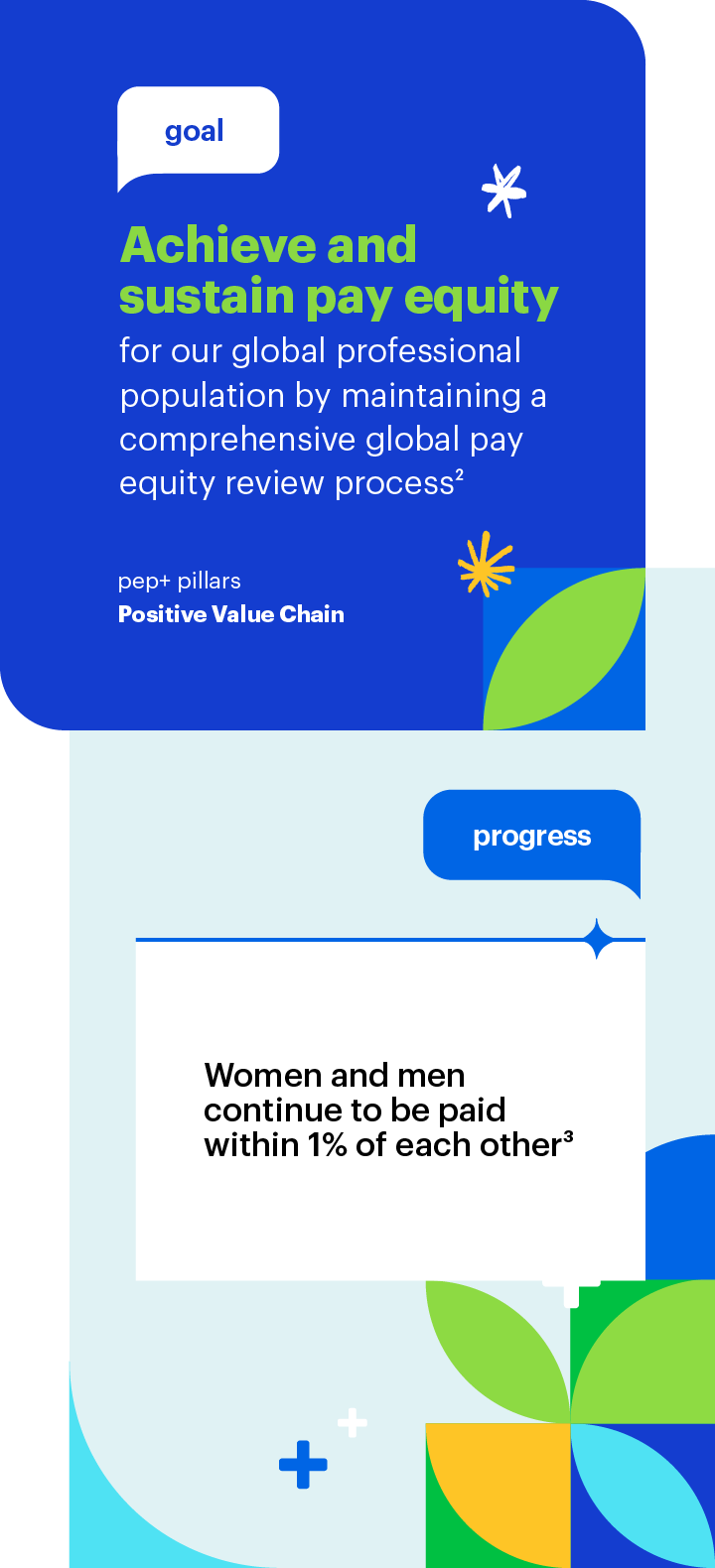
2. After controlling for legitimate drivers of pay such as job level, geographic location, and performance ratings; based on base compensation
3. Based on pay equity program implemented in 71 countries that collectively made up more than 99% of our salaried employee population in 2023, 72 countries included in 2021 and 2022 analysis, representing more than 99% of salaried population
Approach to our Supplier Code of Conduct
Our suppliers play a critical role in our value chain, and we expect them to adhere to the same standards of integrity to which we hold ourselves. Our suppliers are expected to adhere to the expectations contained in our Global Supplier Code of Conduct (SCoC), which outlines our core standards in the areas of ethics, human rights and labor practices, health and safety and environmental management. Our SCoC is updated periodically to reflect evolving international and industry standards, and we offer our suppliers trainings to help them better understand and implement the principles of our SCoC. PepsiCo has also set a goal to extend the principles of our SCoC to our franchisees and joint ventures by 2025.
Supplier Code of Conduct goal
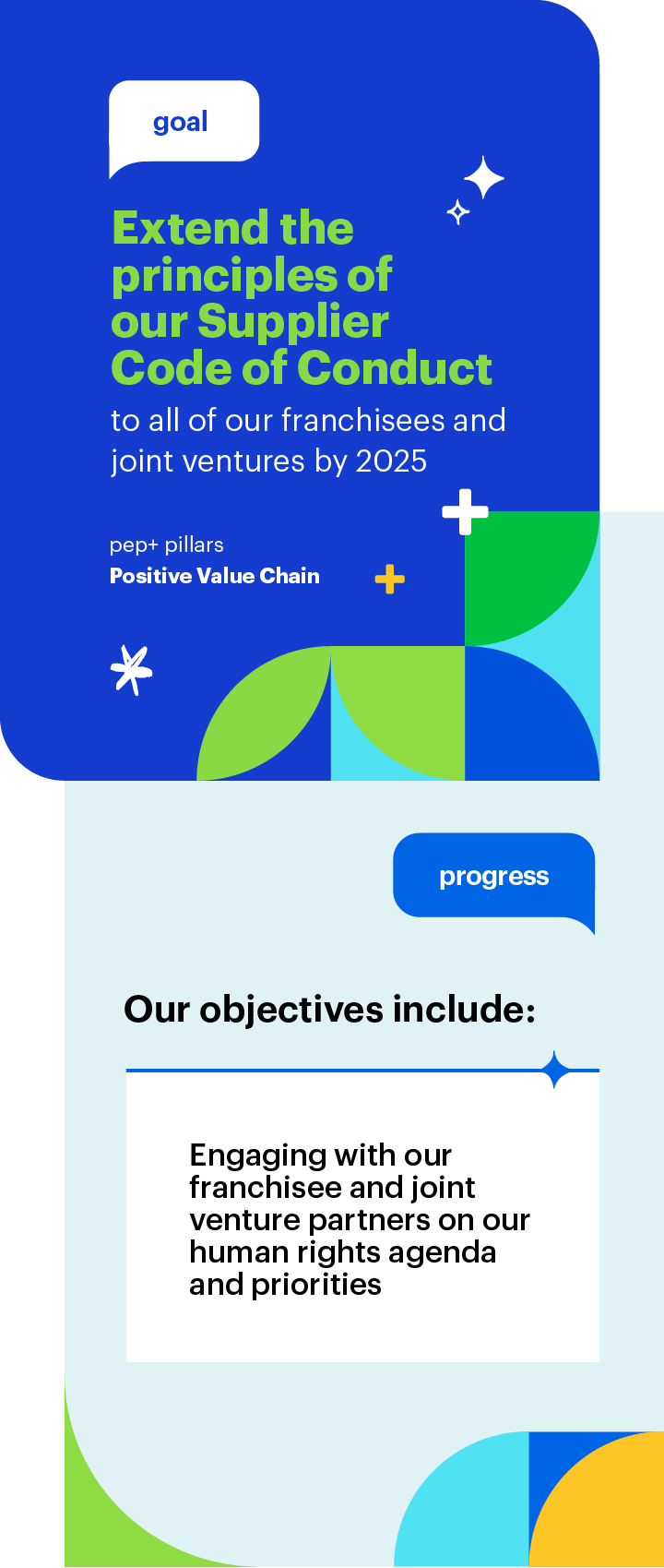
Approach to human rights
We aim to respect the fundamental human rights of all workers and communities throughout our supply chain. We employ a global management approach, grounded in the UN Guiding Principles on Business and Human Rights, to help proactively prevent, identify and address potential risks across our operations and supply chain.
We focus our strategy on our most salient human rights issues to help ensure that we have the appropriate policies and procedures in place to help prevent and mitigate potential human rights risks across our own operations and supply chain. We also closely monitor emerging risks and regularly review our salient issues to ensure ongoing implementation of best practices.
Our salient issues include climate change, fair pay and employment conditions, forced labor, freedom of association, human right to water, workplace health and safety and land rights.
Examples of actions we’re taking to promote human rights include:
- Empowering our direct suppliers through capacity building and collaboration to have similar standards and processes as PepsiCo around conducting human rights due diligence, risk screening, training on human rights risks, risk mitigation, investigations and remediation and reporting on human rights risk and due diligence.
- Sponsoring and launching several initiatives and partnerships to support our overarching goal of promoting fair and safe working conditions. This includes co-funding a forced and child labor prevention initiative through AIM-Progress, an industry membership organization.
- Training suppliers in Thailand and Malaysia on responsible recruitment management systems and risk mitigation protocols as part of our sponsorship of the Ganapati Initiative.
Human rights goal

Approach to striving for an injury-free work environment
A key aspect of our commitment to respecting human rights is fostering fair and safe working conditions throughout our value chain and aiming to achieve an injury-free workplace. We build a proactive environment, health and safety (EHS) culture by driving ownership of EHS performance at the individual, managerial and organizational levels. We engage, collaborate with and train our people and actively encourage participation in building our proactive EHS culture — which we call “Courage to Care”.
At the end of 2023:
- All manufacturing facilities were implementing our Global Environment Health & Safety Management System (GEHSMS) standards, which are designed to reflect both “best-in-class” and ISO standards while providing assurance that our operations are working to improve EHS performance; manage and mitigate EHS risks and impacts; and comply with relevant EHS regulations in the locations we do business.
- Our Lost Time Incident Rate (LTIR) remained nearly flat to the prior year, at 0.48 lost time incidents per 200,000 hours worked.
Injury-free work environment goal
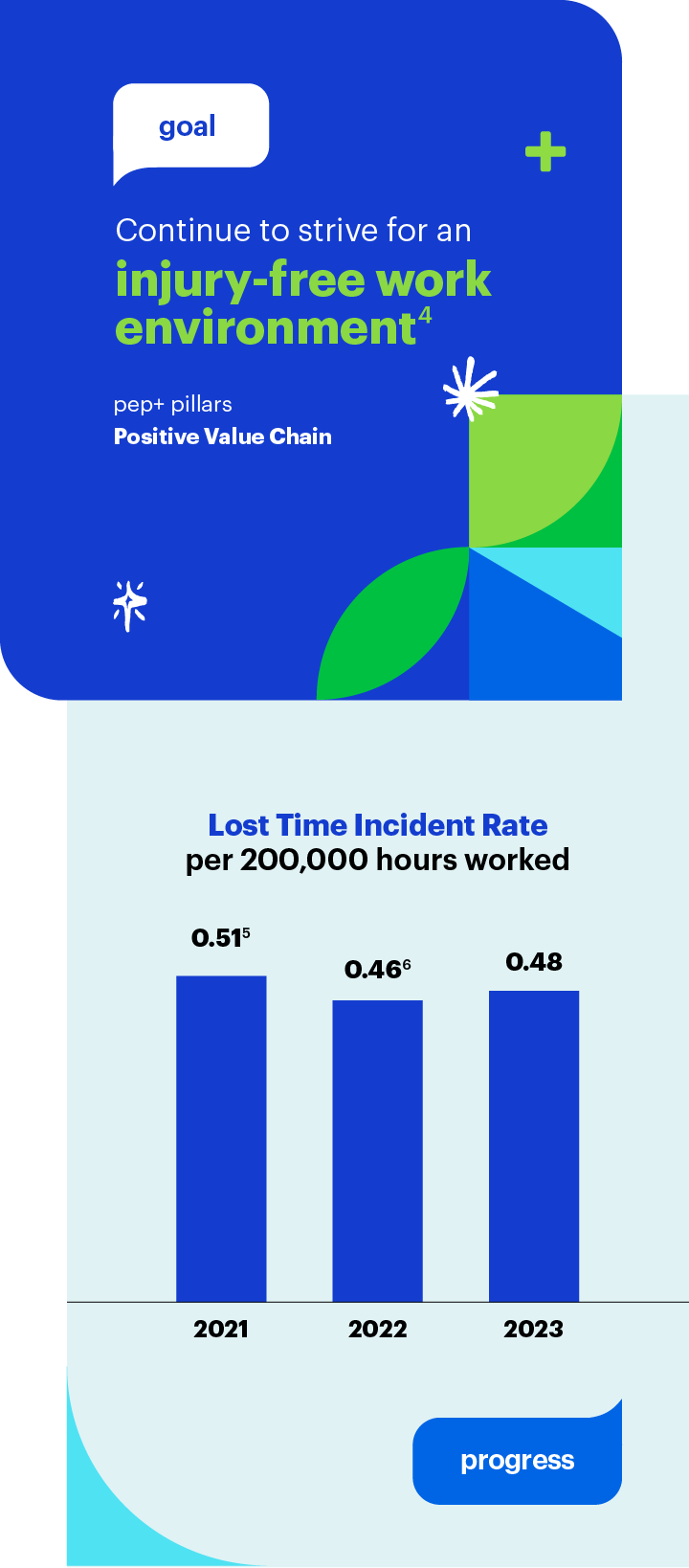
4. Results reflect lost time incidents per 200,000 hours worked
5. Results reflect the exclusion of SodaStream and Pioneer Foods
6. Results reflect the exclusion of SodaStream
Approach to providing safe water access
We believe that all communities should have access to safe water as a fundamental human right to drive health and economic prosperity. Gender equality is another important focus as the burden of unpaid work related to water, sanitation and hygiene (WASH) most often falls on women and girls.
PepsiCo and the PepsiCo Foundation are focused on three paths for delivering safe water access to millions of people in water-risk communities:
- Conservation to increase availability and improve quality of water
- Distribution to improve sanitation services and hygiene training
- Purification through community-based facilities to make water affordable, reliable and safe
As climate change and environmental degradation increasingly threaten access to clean, safe water, PepsiCo and the PepsiCo Foundation have continued to invest in bringing safe water access to millions of people in the water-risk communities where PepsiCo operates. As a result, we have helped more than 91 million people gain access to safe water, including more than 10 million people in 2023, significant progress toward our 2030 goal of reaching 100 million people.
Integral to our progress are our partnerships with NGOs including WaterAid, Water.org, Safe Water Network and the National Business Initiative, as well as local organizations that support on-the-ground efforts. Our safe water access projects are primarily implemented in Latin America, Asia and Africa.
Read more about our efforts to expand access to safe water in the PepsiCo Foundation's Global Impact Report and in the water ESG Topics A-Z page.
Safe water access goal
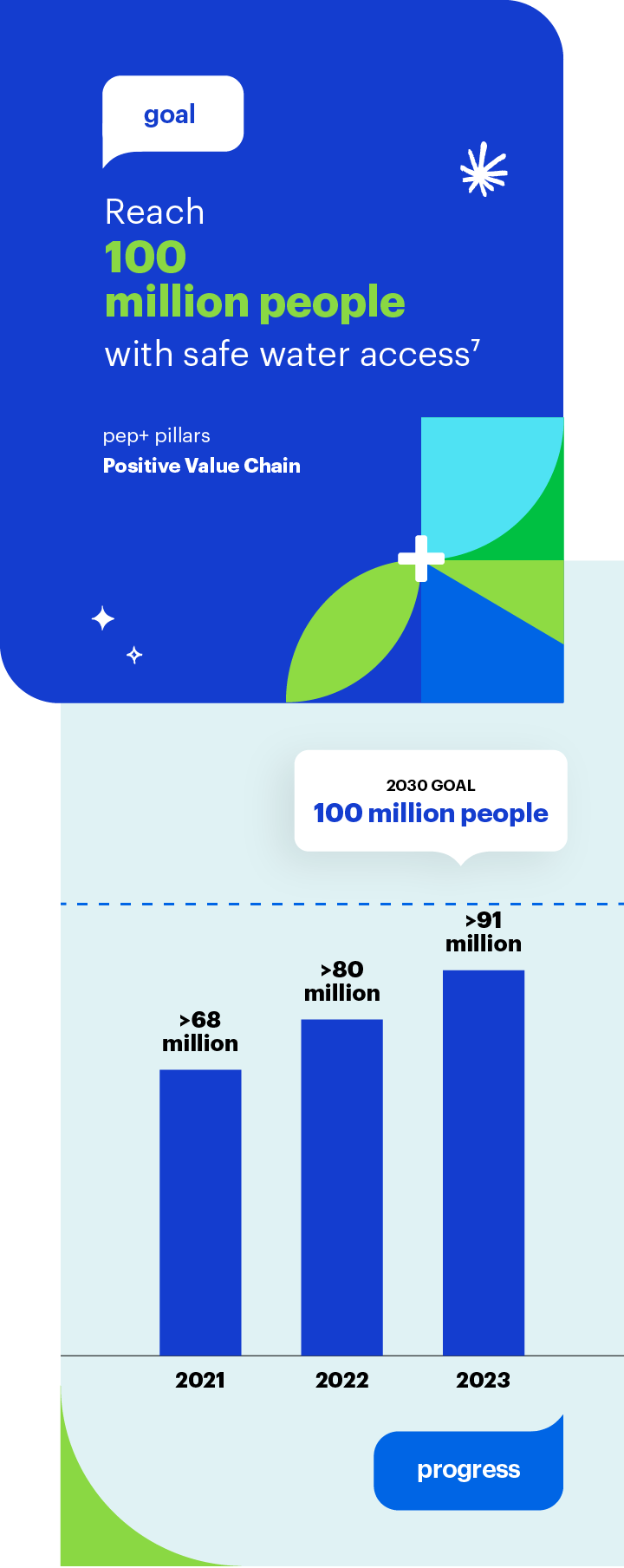
7. Metric counts the cumulative number of people provided with access to safe water since 2006
Approach to advancing food security
In recent years, access to nutritious food has become more challenging for many around the globe due to factors like climate change-induced crop failures, conflicts disrupting food supply chains and economic inequalities for vulnerable communities.
Food security has been at the center of our work for decades, using our global scale to drive local impact in communities where we live and work to increase equitable access to nutritious food. Through strategic partnerships and programs with industry peers, local and international nonprofit and public sector organizations and our employees around the world, we help address some of the most pressing challenges surrounding access to food.
One example is our pledge to invest $100 million in sustainable agriculture and other food and nutrition access programs in priority markets by 2030 as part of the Zero Hunger Private Sector Pledge.
Some of our flagship programs include:
- The PepsiCo Foundation began its partnership with the UN World Food Programme (WFP) in 2008 with a grant to strengthen the capacity and effectiveness of WFP’s supply chain management. Since then, we’ve contributed more than $10 million through various programs to help improve the long-term food security needs of communities affected by climate change, natural disasters and humanitarian crises. In 2023, we supported flood relief efforts for impacted communities in Libya, an effort which is estimated to reach thousands of people.
- Food for Good, PepsiCo and the PepsiCo Foundation’s philanthropic global commitment to advance food security. In the U.S., our Food For Good social enterprise has delivered more than 75 million meals since 2009 and served over two million children from 2016 through 2023 — of which 5.3 million meals were delivered to over 150,000 children in 2023 alone.
- She Feeds the World (SFtW), a multi-country partnership between the PepsiCo Foundation and CARE, aims to improve food security and nutrition of rural households while supporting small-scale women agricultural producers by providing local support to help them adopt regenerative agricultural practices, increase their yields and ultimately increase their income. Since 2018, the PepsiCo Foundation has invested nearly $15 million and reached 1.8 million people, including over 460,000 female farmers and members of their communities in 2023.
Read more about our efforts to advance food security in the PepsiCo Foundation’s Global Impact Report.
Food security goal
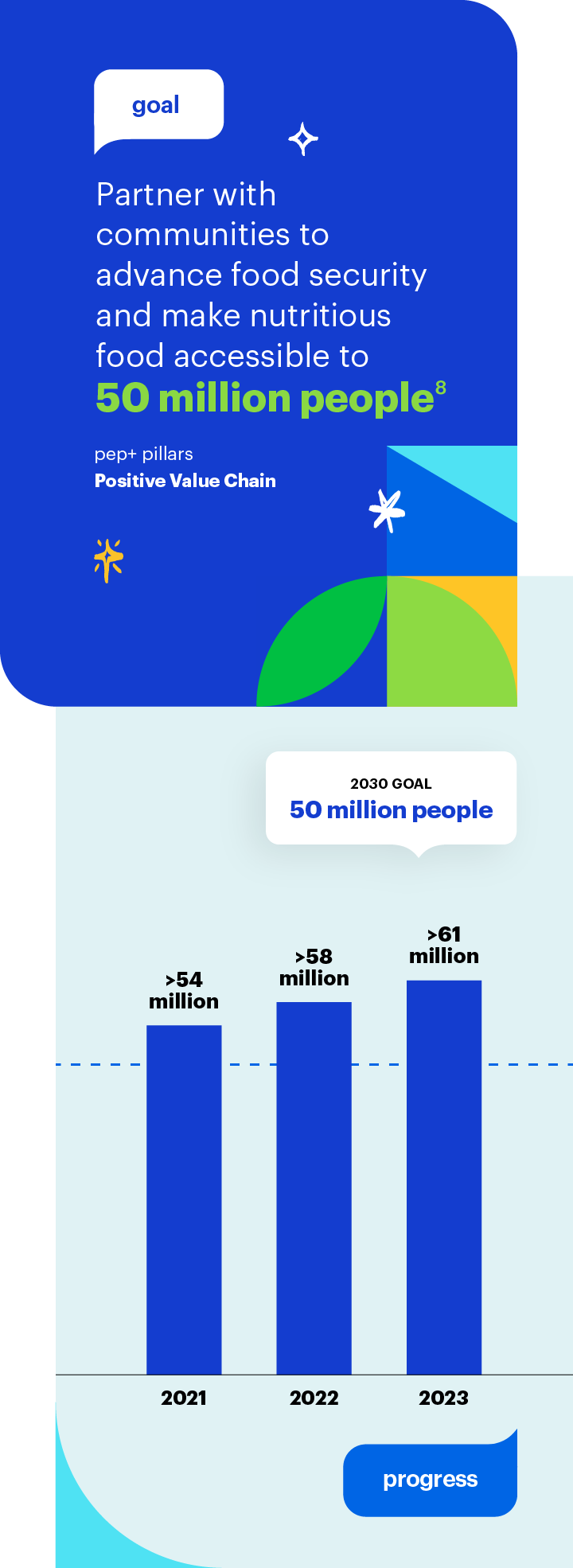
8. Results represent the cumulative sum of people reached with nutritious meals per annual reporting period through programs funded by the PepsiCo Foundation, as well as through commercial efforts that are intended to provide nutritious meals. Initial target setting for this metric did not include Pioneer Foods, which delivered accessibility to more than 20 million people in each reported year. The target will be reassessed in the future to fully account for both commercial and charitable efforts. See Calculation methodology in our ESG Topics A-Z for further explanation of how we calculate this goal
Explore People topics in more depth
PepsiCo's ESG Topics A-Z provides detail on strategy, data, policy, progress and more on a wide range of subjects.
Positive Value Chain stories
PepsiCo Debuts New Customer Sustainability Platform Designed To Deliver Critical Solutions Most Needed by Customers
Learn more Frito-Lay Expedites 2040 Net-Zero Emissions Goal with Over 700 Electric Delivery Vehicles
PepsiCo Beverages North America announces funding for four additional water replenishment projects driving further progress toward goal of becoming Net Water Positive by 2030
Frito-Lay and Quaker Open New Industry-Leading Greenhouse Learning Center to Fast-Track Sustainable Packaging Innovation
PepsiCo Announces It Will Eliminate Plastic Rings on Beverage Multipacks Across U.S. & Canada By Introducing Recyclable Paper-Based Designs
Our 2023 ESG Performance Metrics
This download contains detailed performance data, tracking progress against our goals over the past three years.
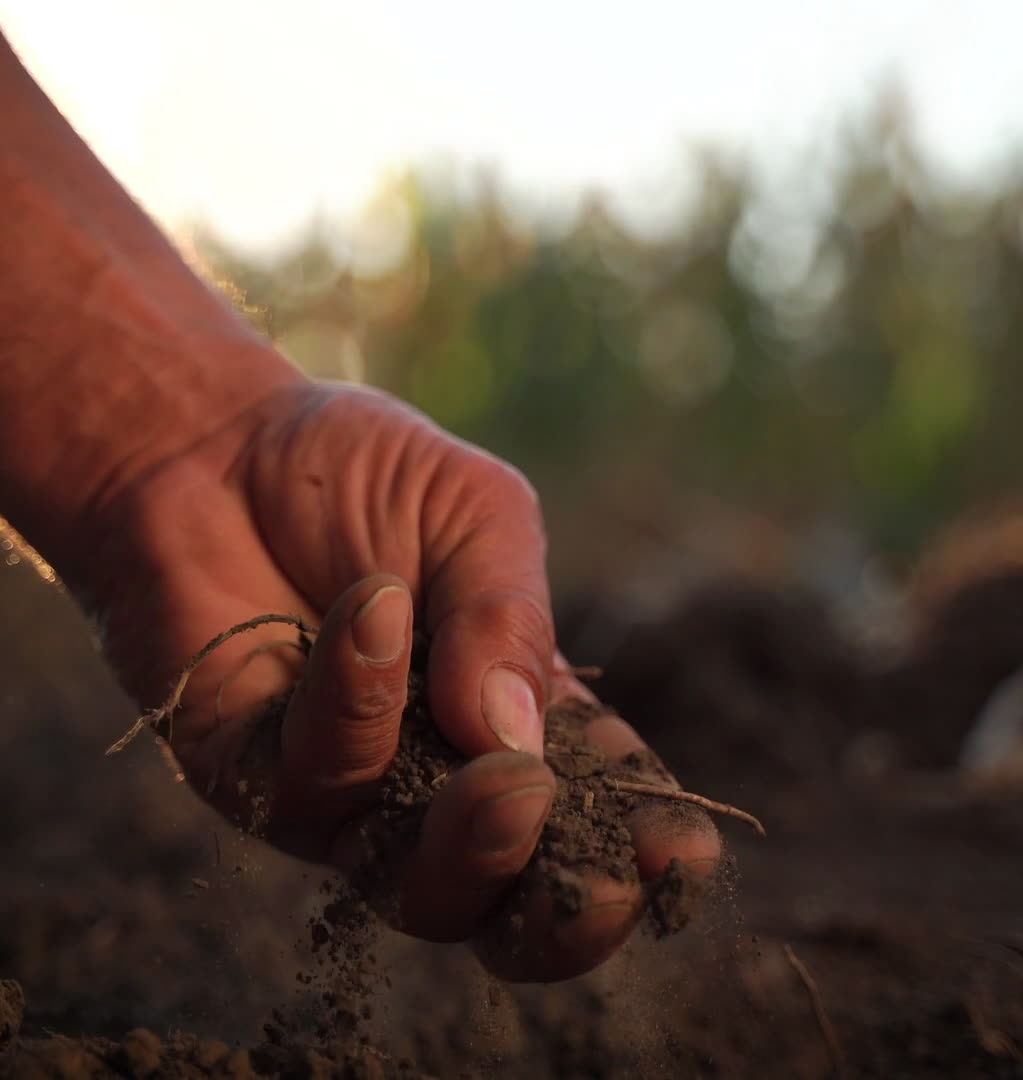
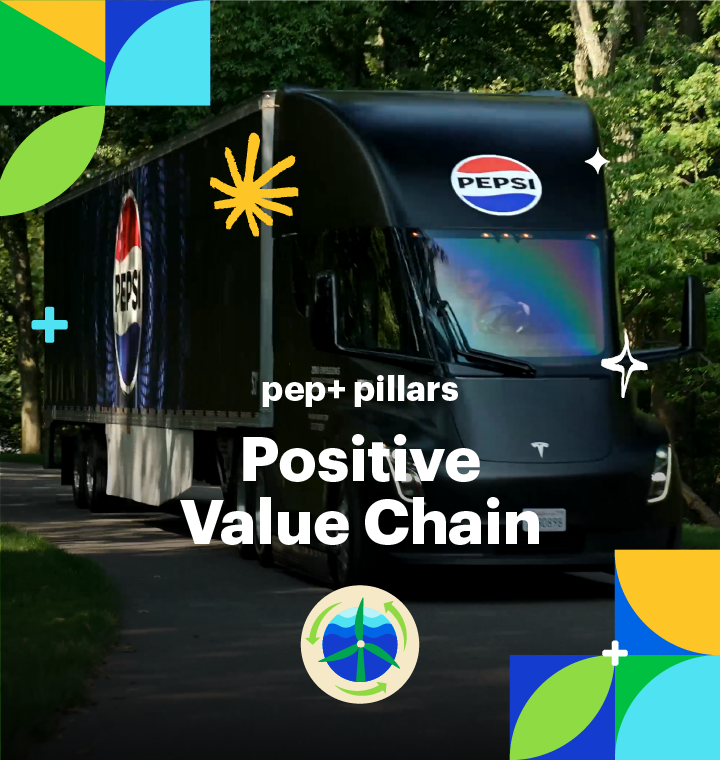

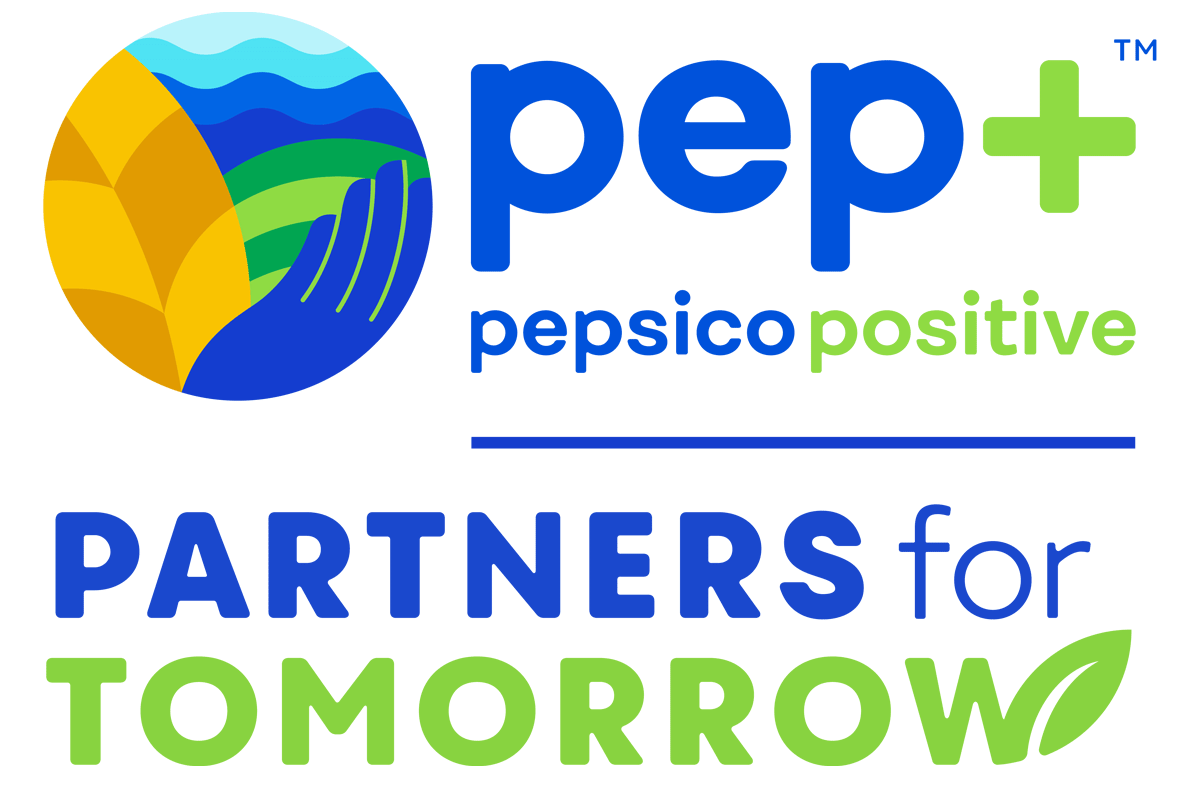
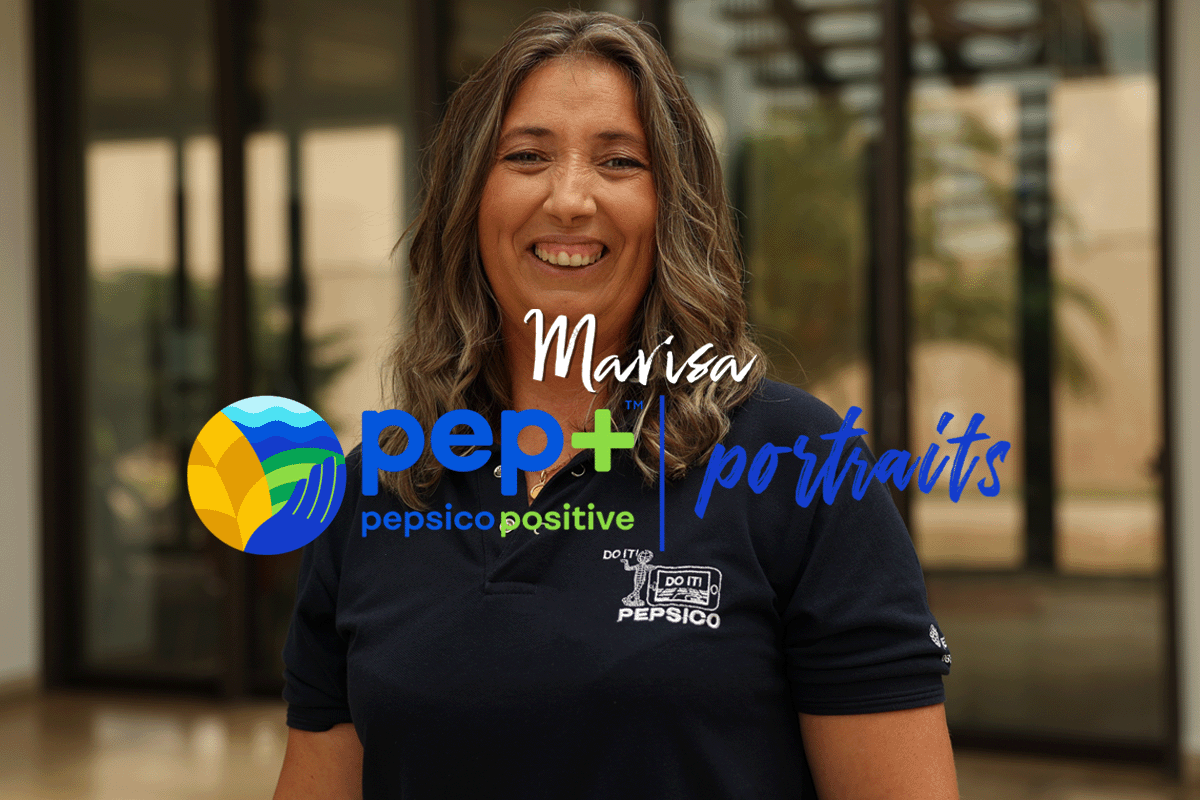
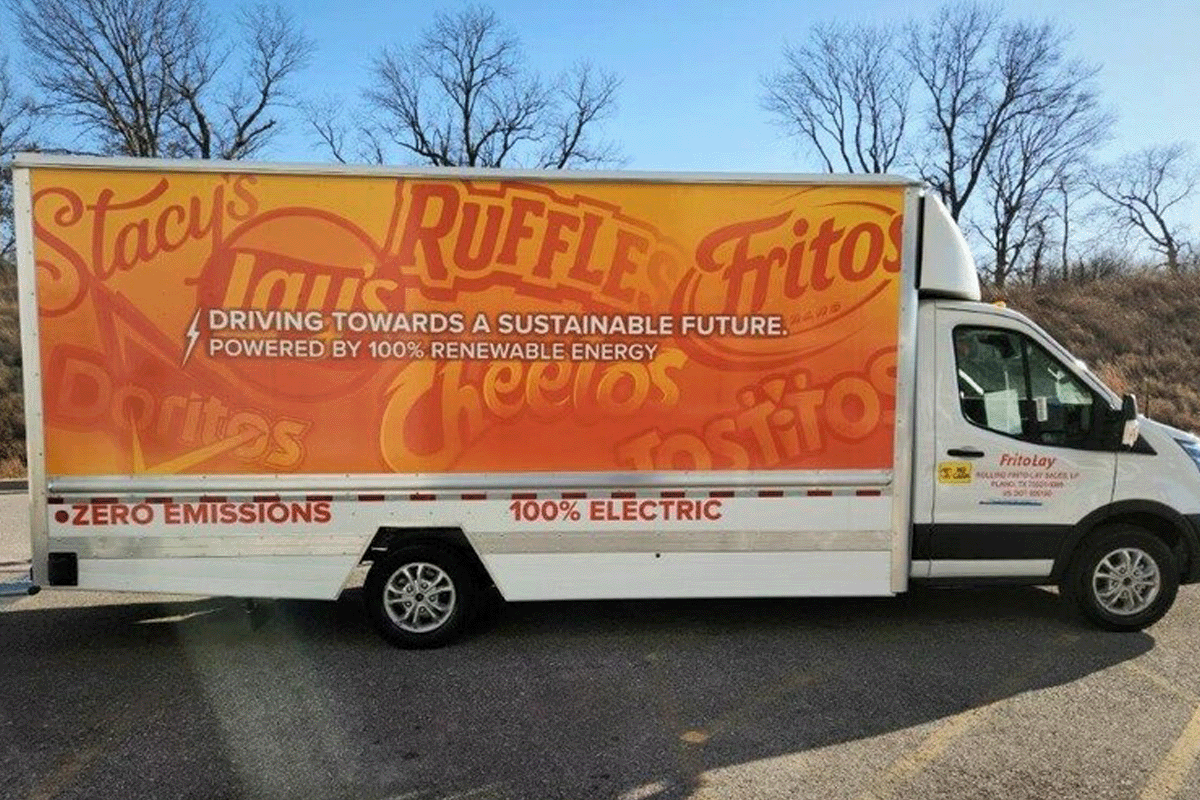
.png?sfvrsn=196820e7_0)
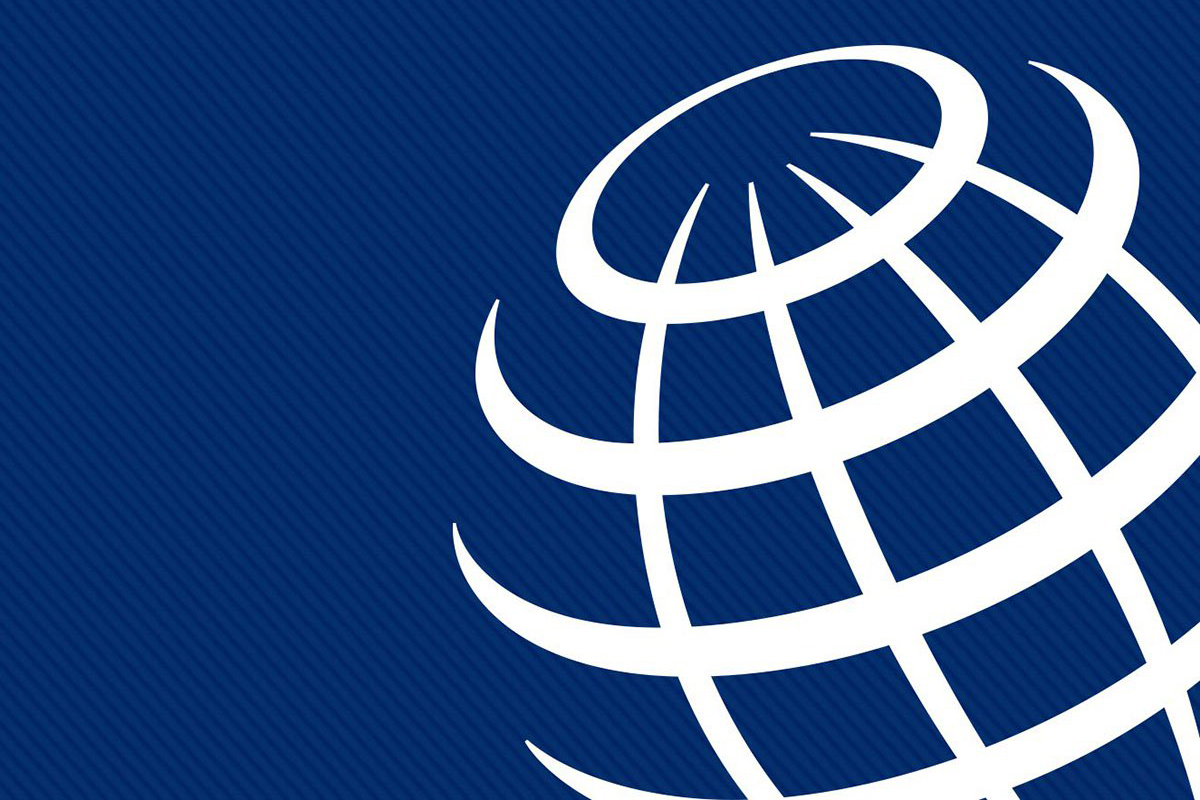
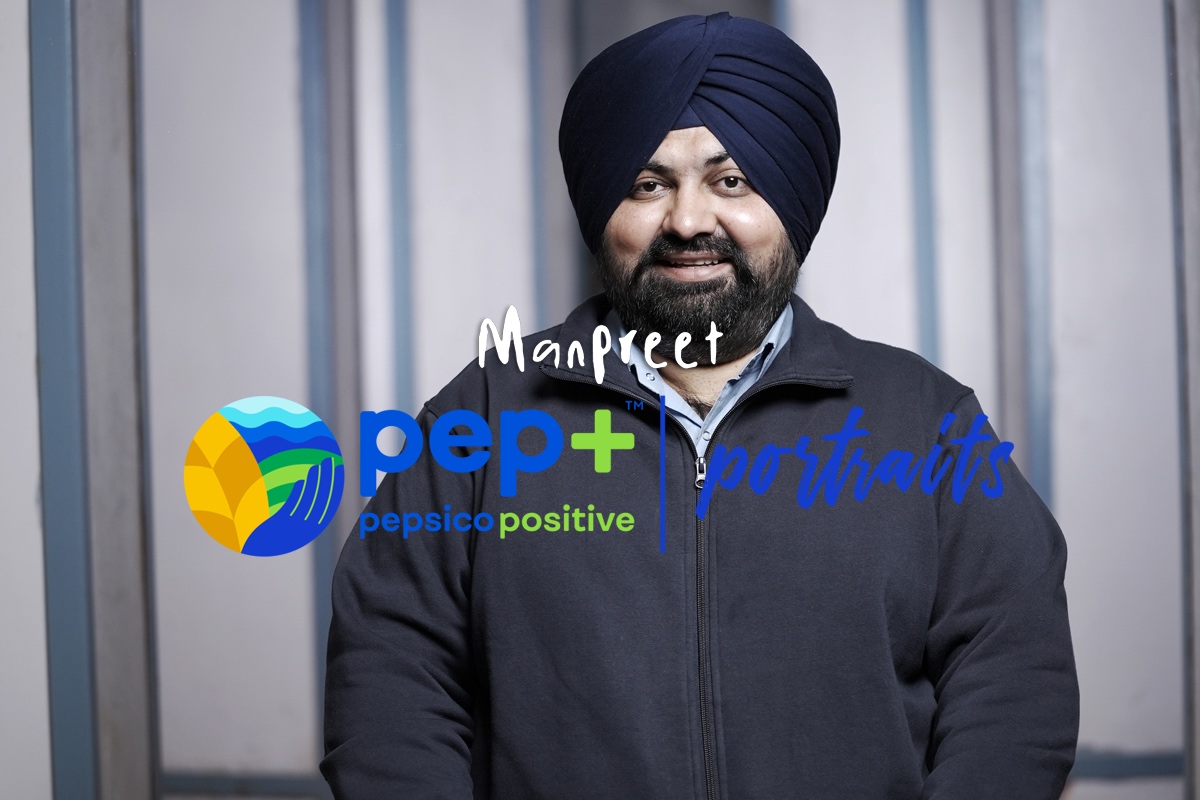
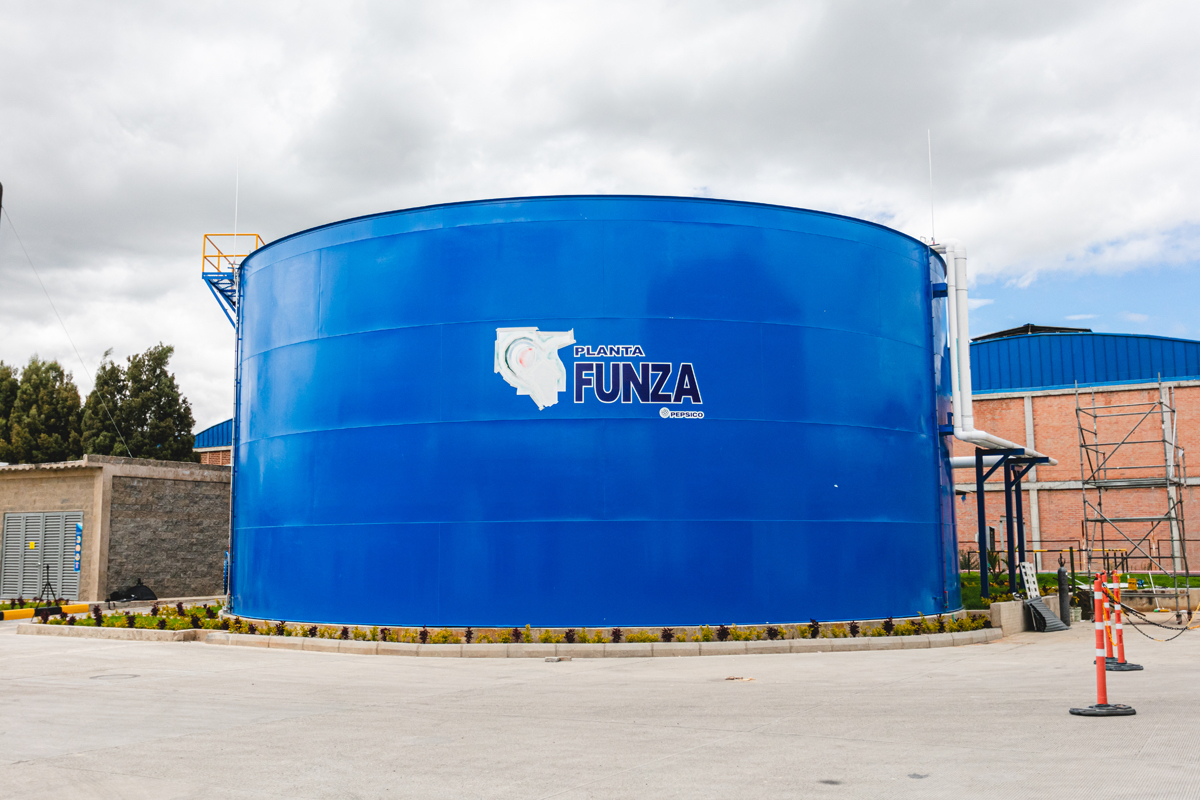
e624b97c397b4a35950ab3a8d5917cc3.png?sfvrsn=6c5ff38a_0)
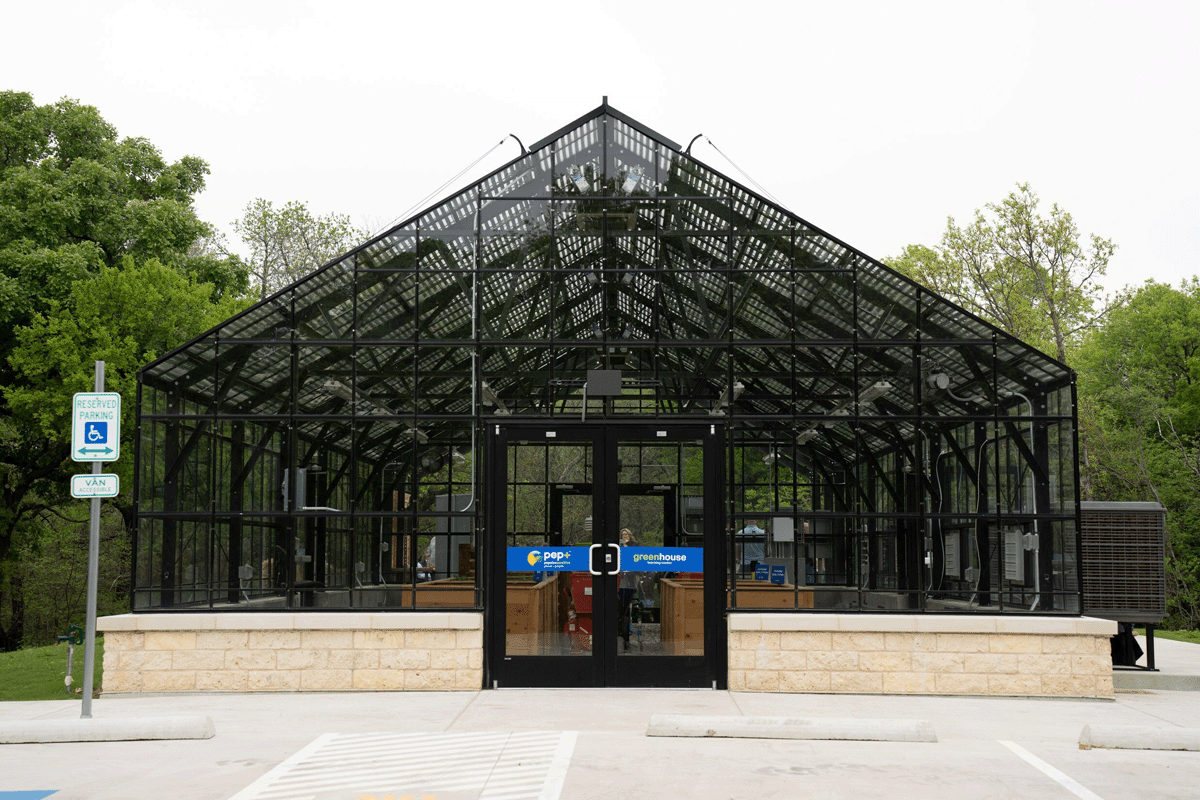
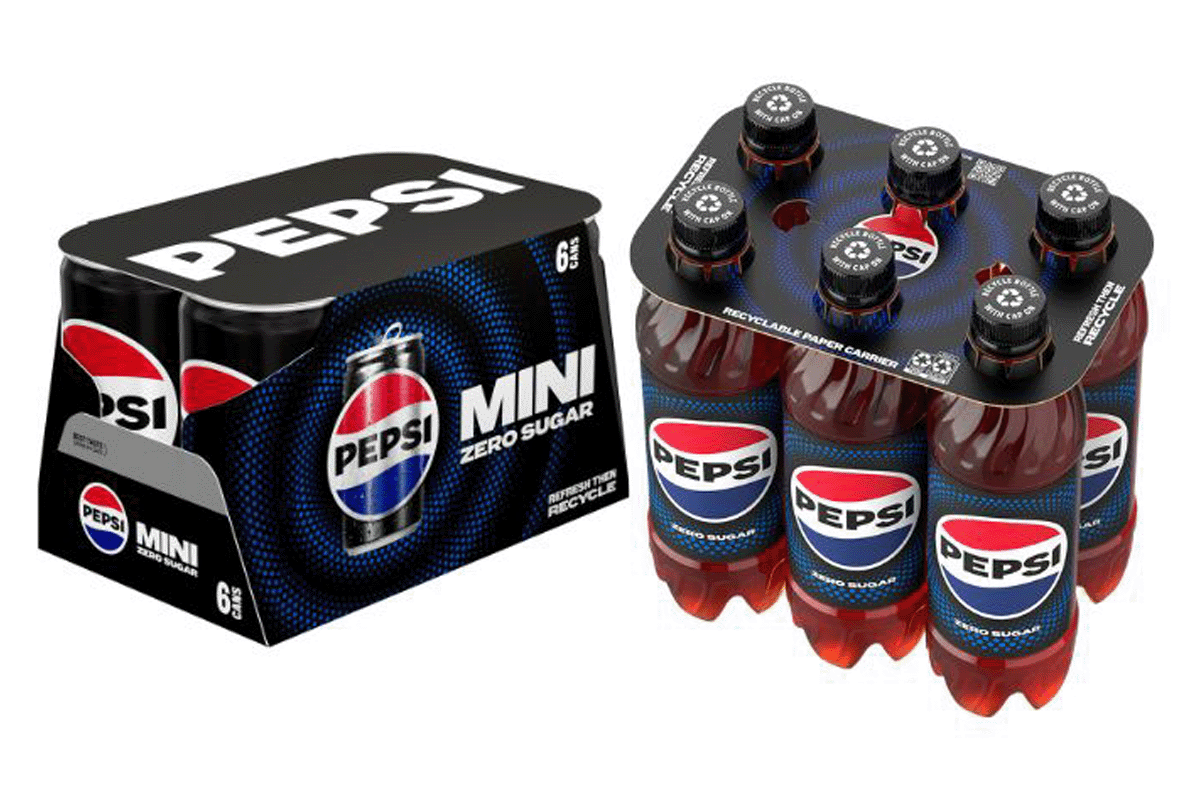
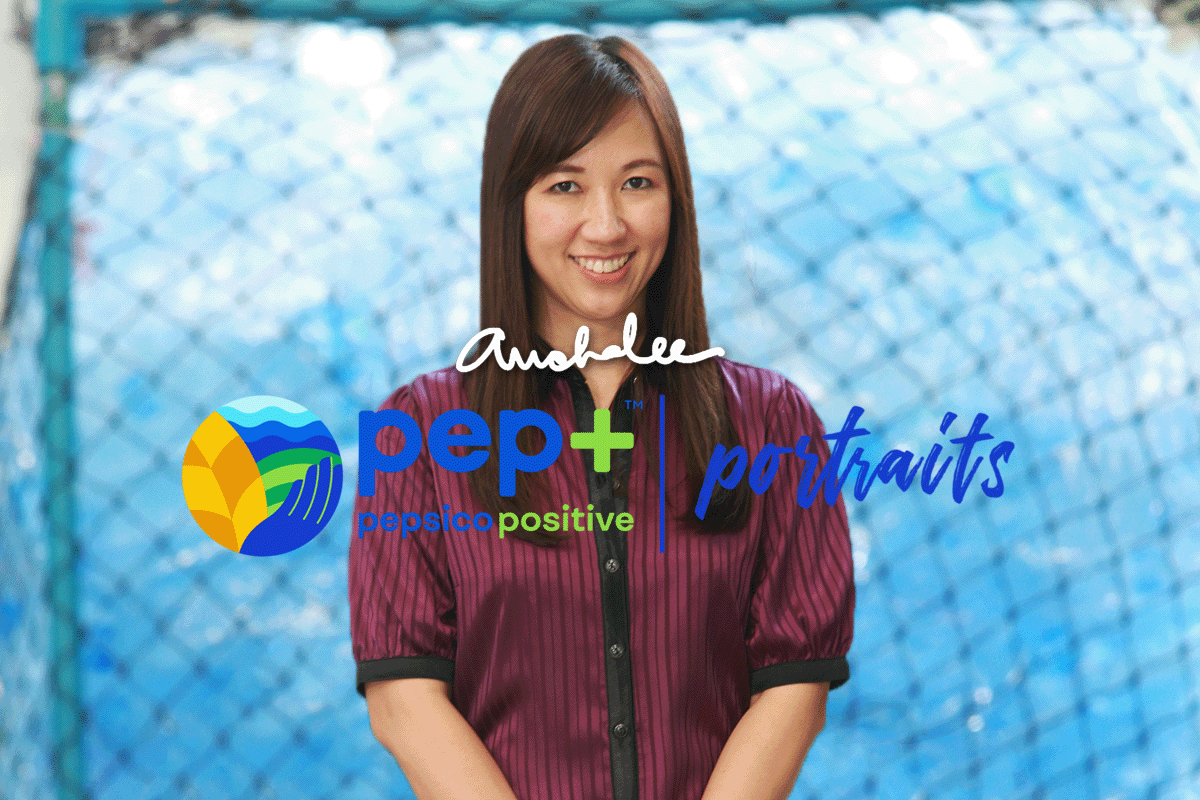
420121cdc23b4935806989053f436f56.png?sfvrsn=93a68ae_0)

